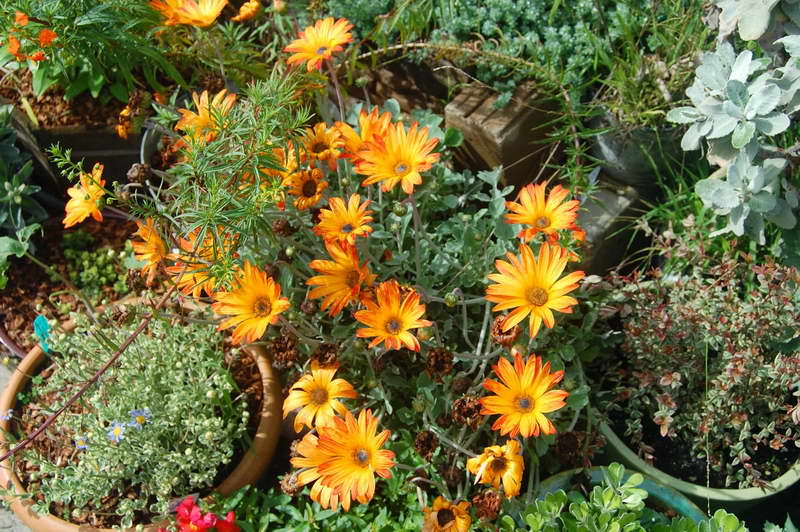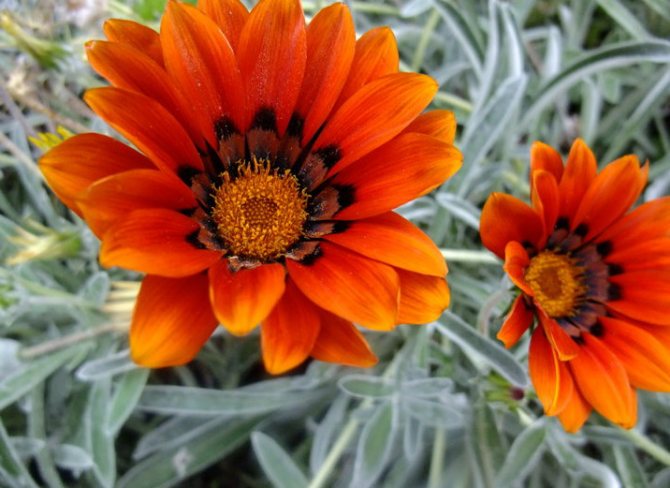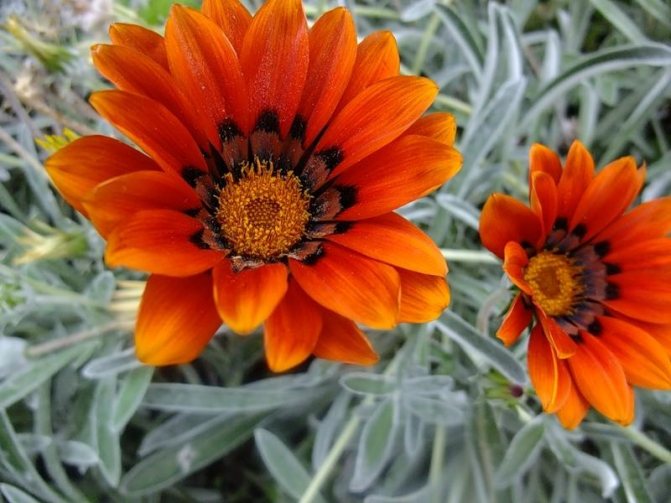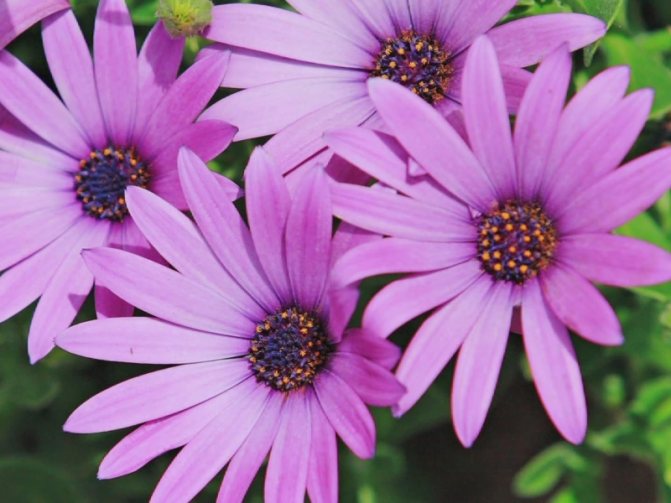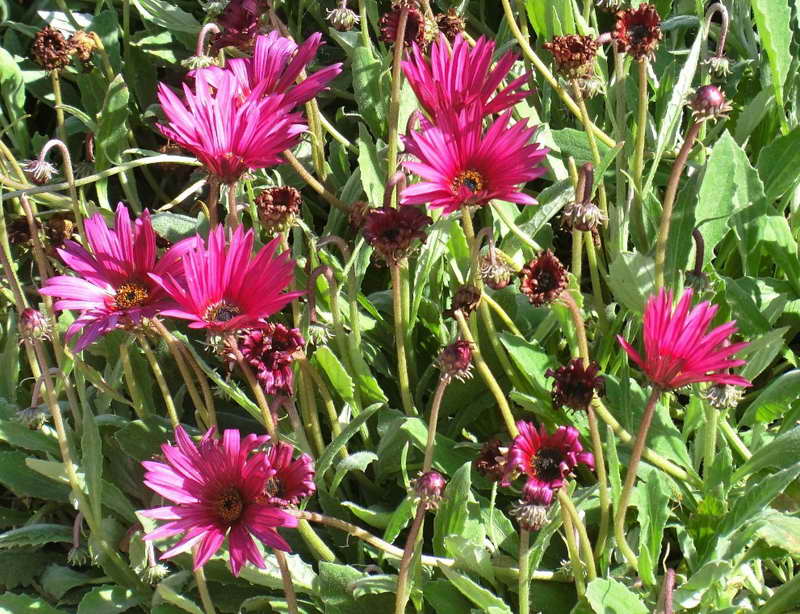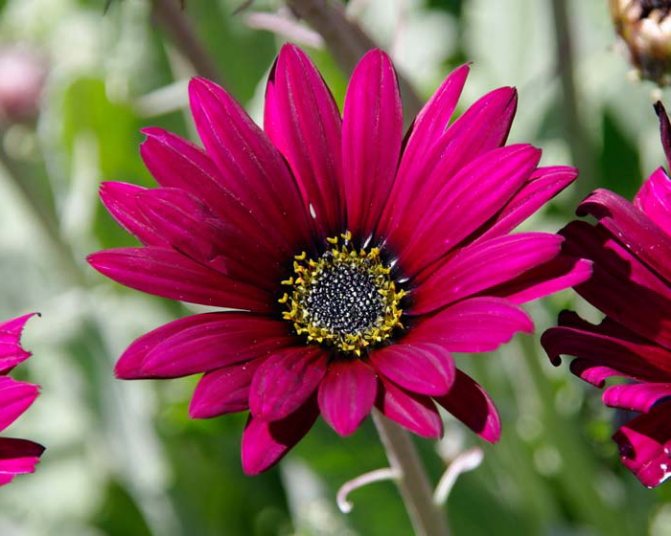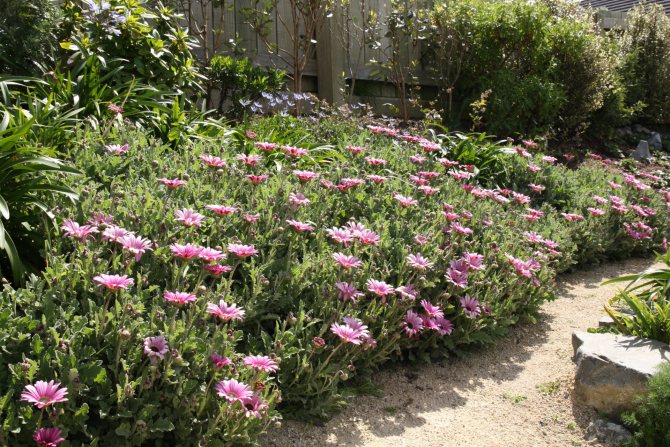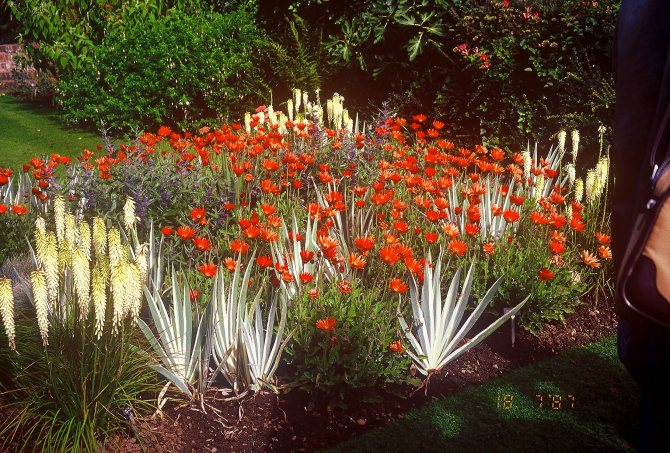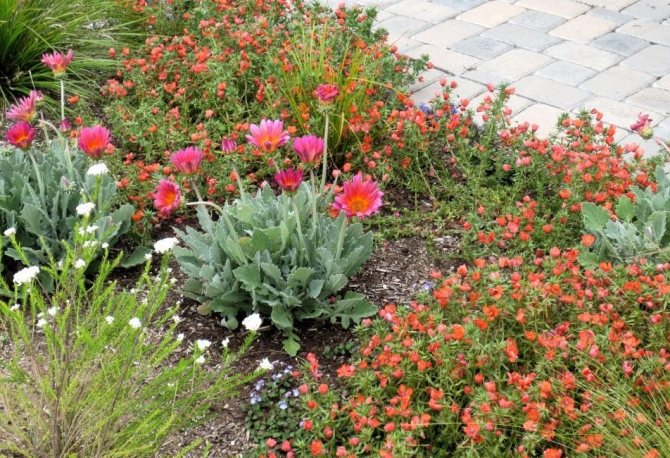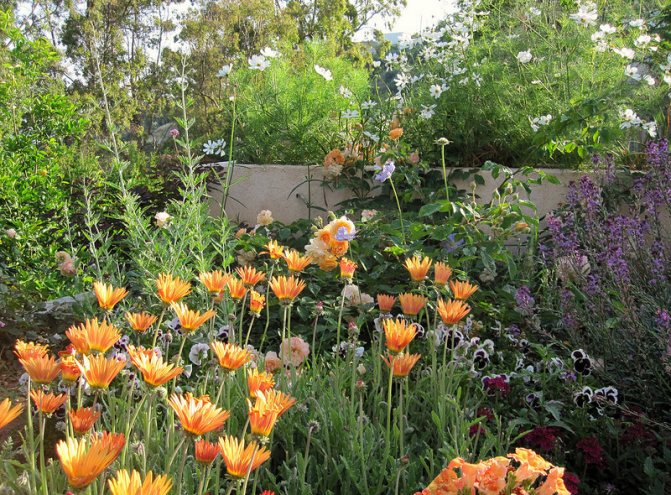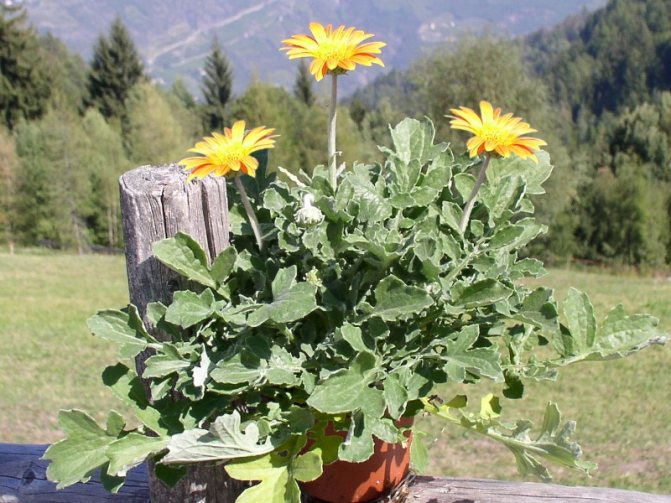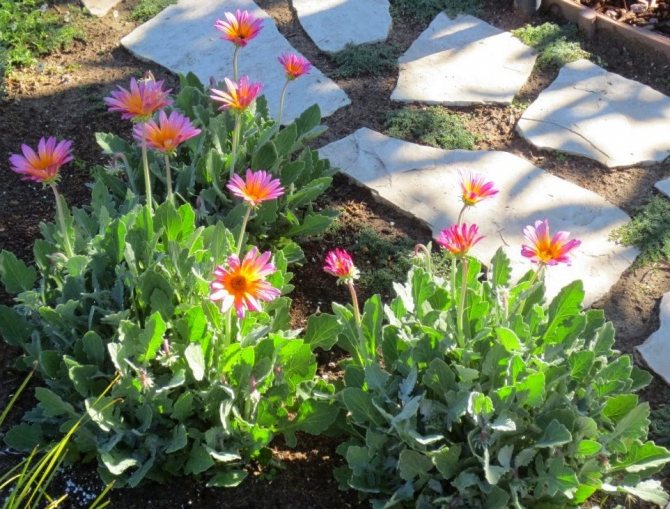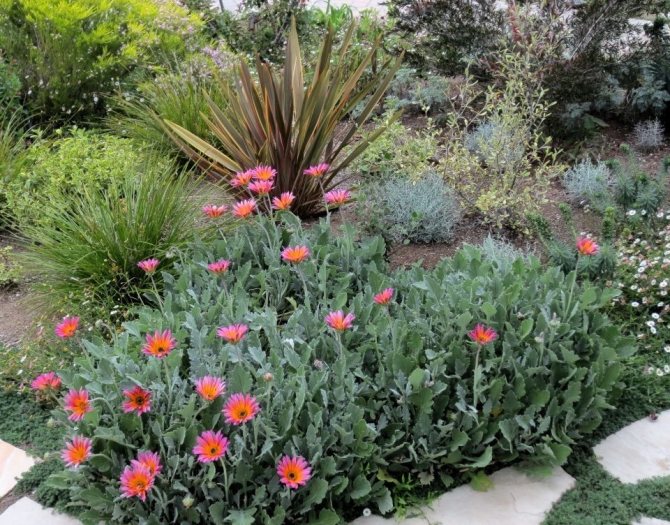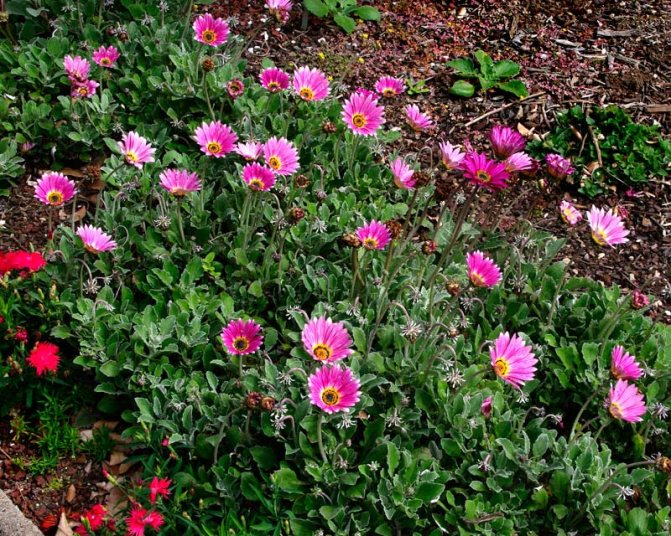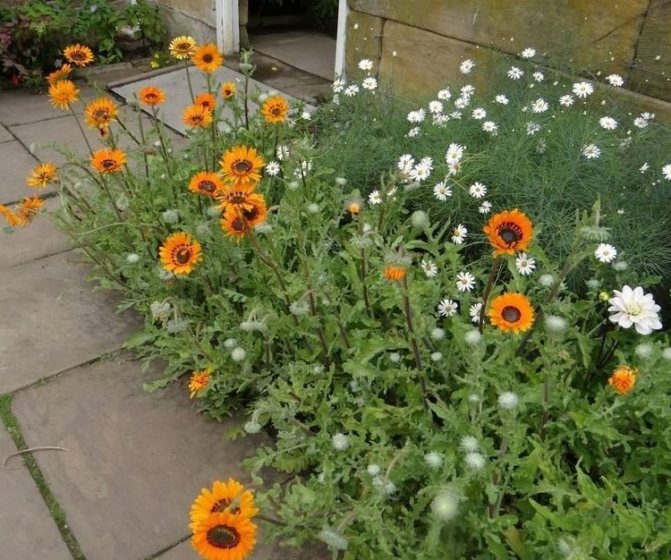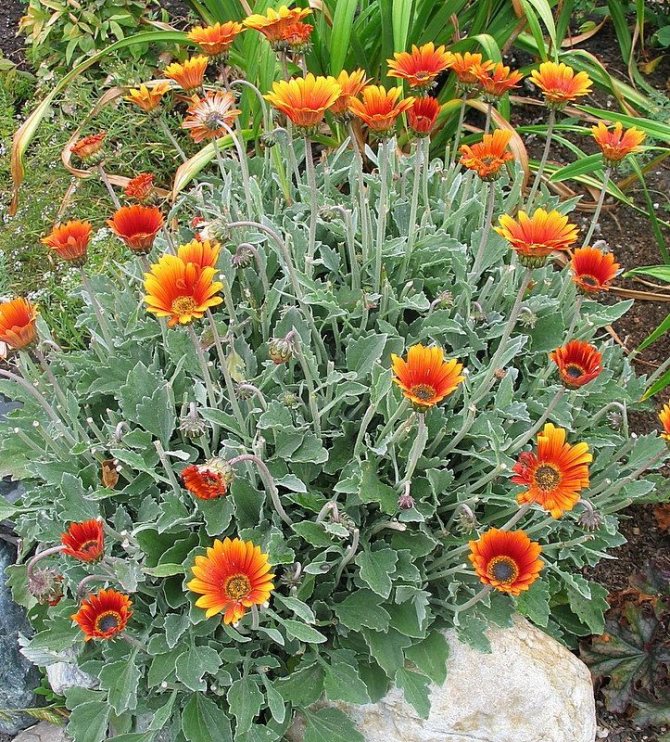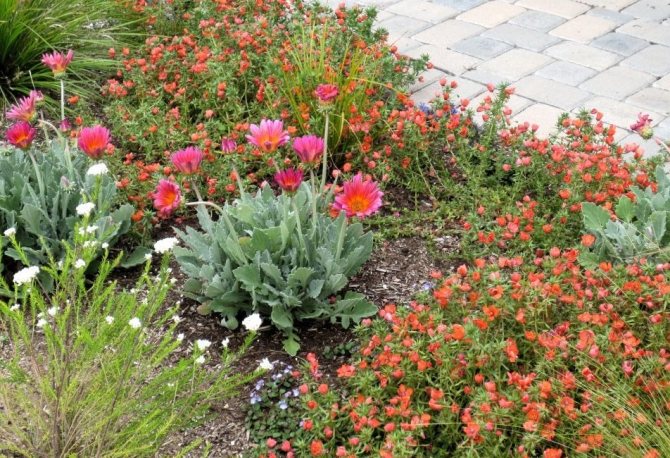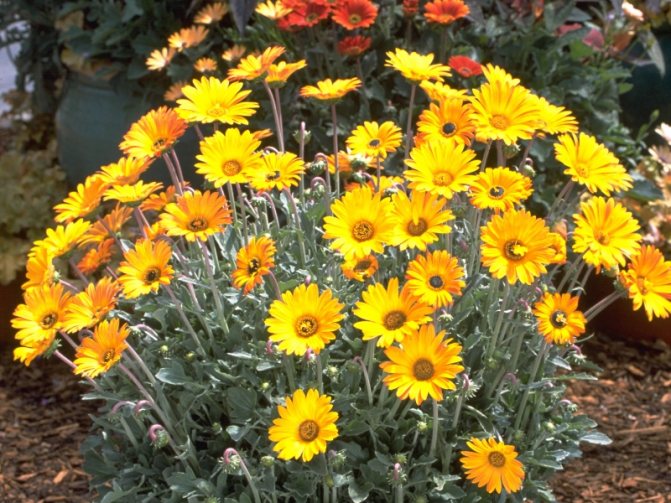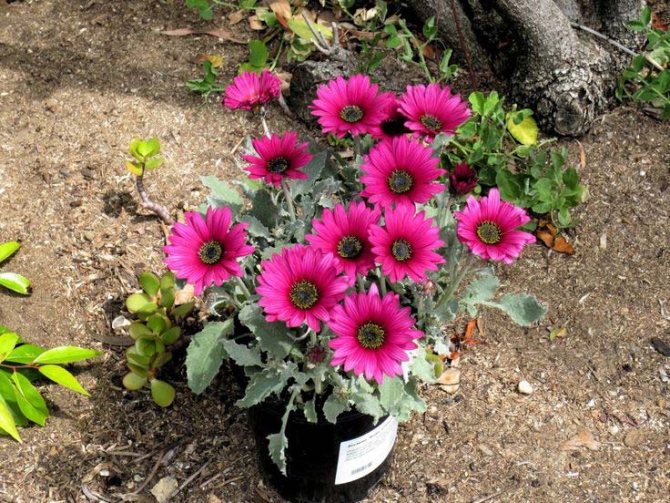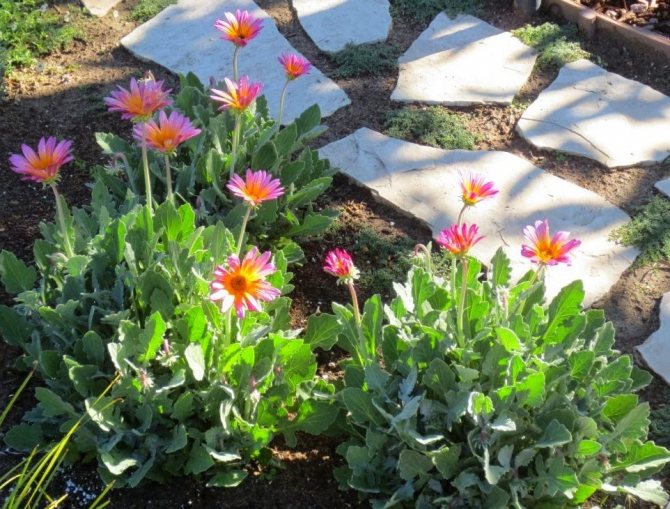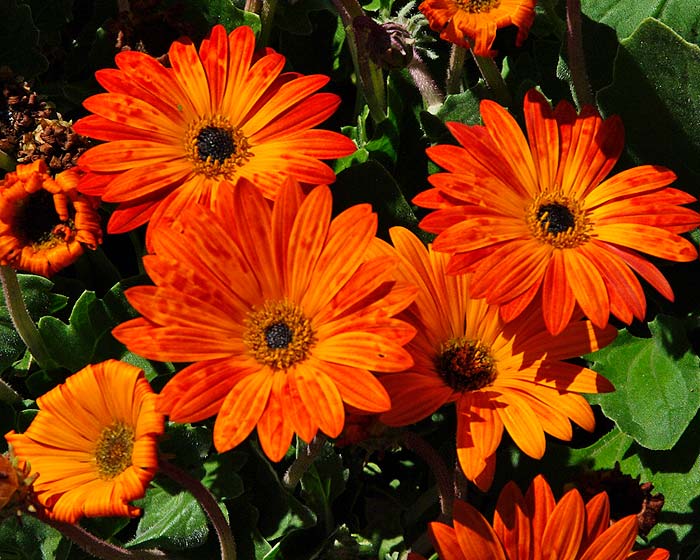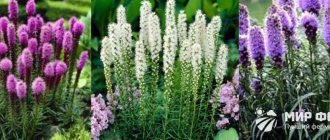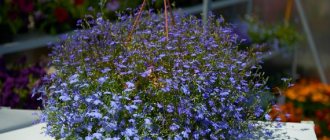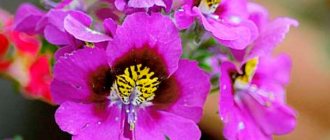The variety of modern species of flowering annuals allows you to create a wide variety of paintings in the garden. Long-term flowering can be organized with the help of correctly selected species and varieties. Arctotis flowers belong to a large family of Asteraceae and Asteraceae, they can be grown from seeds by seedlings. In this case, we get a long flowering before the onset of the first frost. This article describes the whole process - from planting seeds to organizing proper care in open ground. There are also some varieties of arctotis, which are grown in groups to create gorgeous colorful pictures. All the subtleties of agricultural technology are told by experienced flower growers. This knowledge base will allow you to get speckled and healthy plants. In the meantime, we suggest looking at arctotis in a photo showing the diversity of this culture:
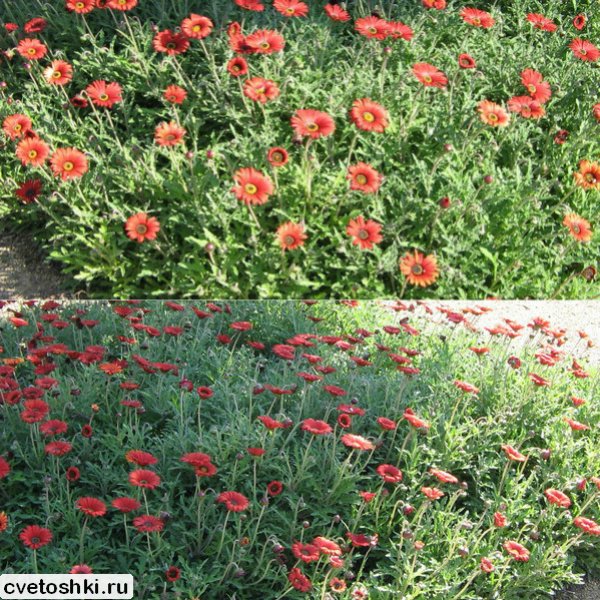
Arctotis species
There are quite a few natural species of arctotis, but only a few of them are used in cultural breeding. The most popular types are:
Stechasoliferous
Most popular in horticultural breeding. Shoots 1 m with rather large drooping leaves.
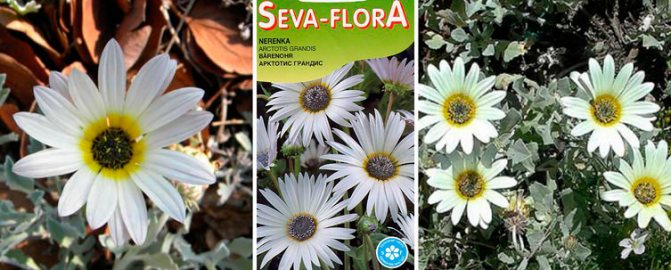

The peduncle is tall with a single flower of a light yellow or milky white shade with a dark center with a purple tint.
Lush
Natural species, the progenitor of many hybrids. The flowers are bright orange or yellow.


Bushy with flowing shoots.
Acaulescent
Thick, lush rosette. Orange, red inflorescences.
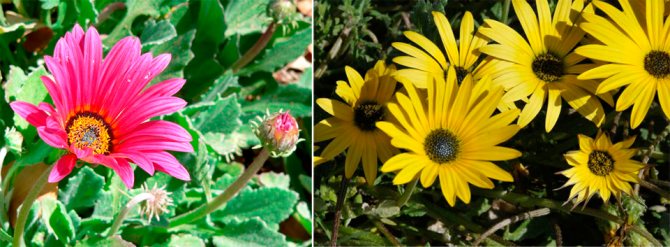

The height of the peduncles is 20 cm.
Short-stemmed
Compact bushes with foliage, small yellow flowers. Height up to 15 cm.
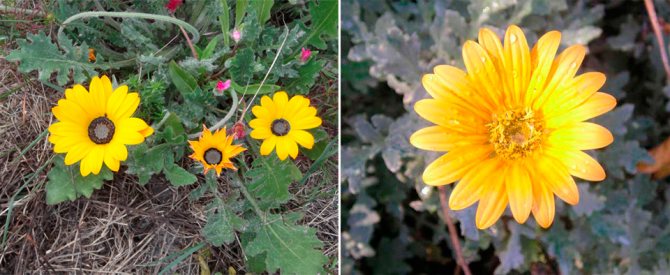

Rough
Inflorescences are medium in size, white, yellow flowers. Fragile root system. Height up to 1 m.
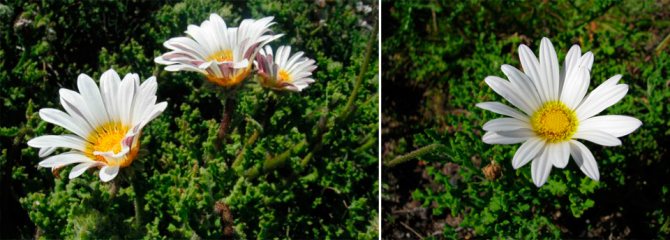

Eared
Its only difference from other species is its orange inflorescences.
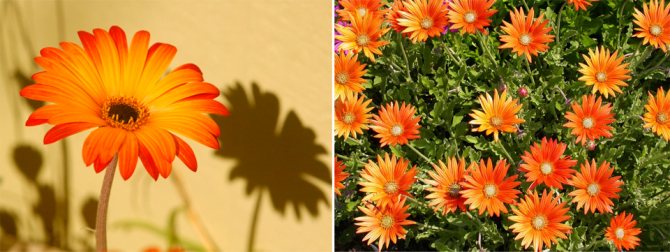

Beautiful
Speaking name, rare species. The height of such a specimen can reach 30 cm, the flowers are orange.
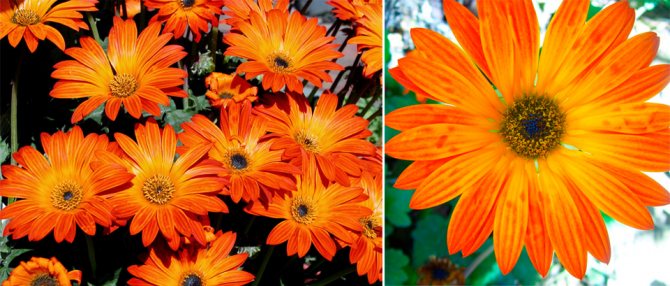

Large-flowered
It differs from other species due to the color of the inflorescences, they are covered with a silvery tint, giving the plant uniqueness.
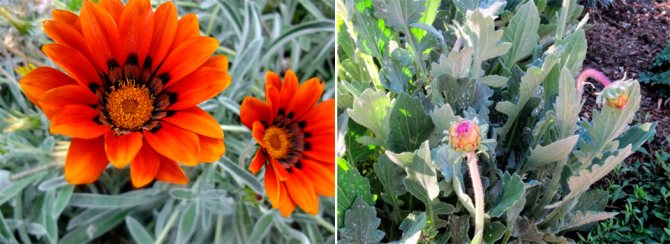

Hybrid
Very large inflorescences, a huge list of possible colors, from white to orange. The buds grow up to 10 cm in diameter.
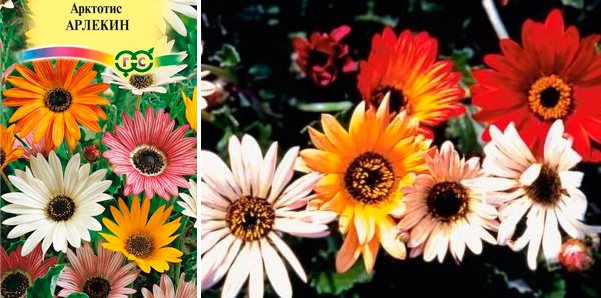

The height of the flower itself is 20 cm-1 m 20 cm. The seeds do not convey the characteristics of the species. The most popular variety is Harlequin.
Choosing a variety for planting
About 30 species of this beautiful plant are known, differing in shape and size:
- annuals and perennials;
- with a herbaceous stem and shrubby;
- undersized and tall.
Only five are popular for growing from seeds:
- stochasolistny - strongly branched, tall, erect, with large flowers;
- lush - medium-sized, bushy, with a lush curtain;
- stemless - undersized, with a powerful root system;
- short-stemmed - dwarf compact variety;
- rough - medium-sized variety with yellow-brown baskets.
Hybrids have increased vitality, increased size and accelerated growth.
Photo of growing varieties of Arctotis from seeds and a brief description:
- Arctotis stochasolistny is a tall species with single inflorescences up to 8 cm.The variety gave rise to a hybrid form of this type: elongated leaves and large reed inflorescences with a yellow-brown heart and tubular flowers, similar to chamomile or gerbera. In arktotis flower beds, cultivation takes place in the middle ground.
- Arctotis lush - has fluffy ribbed basal leaves with brightly colored inflorescences that resemble tongues of flame. Representatives of this species have hybrid varieties, the height of which varies from 20 to 120 cm.
- Arctotis stemless - this species is distinguished by a dwarf pale green rosette of leaves with small red or orange flowers. Depending on the region, it is grown as an annual or perennial crop, and can be grown in pots as an indoor crop.
- Arctotis short-stemmed is a short bush up to 15 cm high with dissected carved leaves, the tongue of the peduncles is of a rich bright orange color. Growing is done in the foreground.
- Arctotis is rough - the stems of this species reach a meter in height, towering above their counterparts, and admiring the splendor of the color, which changes from a contrasting dark brown in the core to a white or light yellow shade to the edges.
- Arctotis hybrid Harlequin - combines in its culture all the species diversity of these amazing flowers: from dwarf bushes 15‒20 cm high to tall specimens reaching a height of 100‒120 cm, and the color palette varies from snow-white to carmine red and purple.
Growing arctotis from seeds
Planting seeds can be purchased at any gardening store. Or to collect them in places where these flowers grow, this method is more difficult, but better. It allows you to be 100% confident in the quality of the seeds. However, they are very small in size, it is important to know exactly when to collect them. You can prepare a large amount, but use only a part, leaving the rest for later. They have excellent storage properties.
The nuances of planting arctotis seeds
Seed ripening takes 2 weeks after flowering. The most common method is seedling. If you plan to land in the southern regions, places with a warm climate, you can plant it directly into open ground.
There are a couple of important nuances in the issue of disembarkation:
- It is necessary in advance, around March, to sow the seeds in a container filled with a peat-sand mixture.
- Soil treatment with potassium permanganate solution. This will help eliminate most infections and diseases.
Growing seedlings
Arctotis seeds should be scattered over the soil surface. Then you need to cover with foil or glass. It is important that the temperature does not fall below +22 ° C, does not rise above +24 ° C. The emergence of sprouts can be observed a week after planting.


Upon detection of the first shoots, it is necessary to remove the material with which the seeds were covered. The issue of watering should be approached with extreme caution, it is recommended to produce through a pallet. Spraying is not worth it, this can disrupt the process of seedling growth. After a time, when the seedlings grow enough, it will be necessary to thin out.
Immediately after the appearance of the first grown true leaves, the sprouts must be transplanted into separate containers. Can be combined, holds up to 3 pieces in one pot. It is necessary to transplant carefully, due to its small age, the structure, the root system of the plant is very fragile, it can be easily damaged if handled carelessly.
A large percentage of risk can be eliminated by planting seeds in special peat tablets from the very beginning. Then, when they reach normal growth, about 10 cm, pinching is recommended to increase bushiness.
Landing
Reproduction of arctotis by seeds is carried out by sowing open ground in the first decade of May or through seedlings - for this, sowing is carried out in greenhouses and greenhouses in March-April.
Arctotis short-stemmed
With the seedling method, the following sequence is followed:
- Seedlings will require wide containers.
- In the absence of a greenhouse, the crops are covered with wide glass or foil.
- The first seedlings will become noticeable in seven days, after them the rest will hatch - arctoris germinates unevenly.
- Watering the seedlings is moderate.
- After 3 weeks, the seedlings dive into separate pots.
Important. You should be prepared for the fact that the roots of the plant are long, so the cups are chosen at least 9 cm high.
Landing in open ground is possible in the last decade of May. Low-growing varieties are planted at a distance of no closer than 20 cm, tall ones need more space - about 40 cm.
Growing arctotis in the open field
Disembarkation is carried out in late spring, in extreme cases, at the very beginning of summer. During this period, there is no opportunity to freeze plants with cold soil. When choosing a landing site, you need to give preference to areas well-lit by sunlight. This is due to the arctotis' love for bright places.
The root system of the plant is delicate, very sensitive. As a result, it should not be planted in clay soil, as it will be difficult for the roots to cope with it, which will seriously affect growth.
As for fertilizers, they are not whimsical; for better growth, it is necessary to provide drainage by adding sand to the soil.
Pest control
Arctotis flowers are resistant to diseases and pests. Sometimes plantings can suffer from aphids or root rot.
Aphids are small insects that feed on plant sap. Many pest species can carry disease. The first visible signs of damage to the Arktotis flower - the leaves begin to turn yellow and curl, small greenish or black bugs appear on the shoots. Most often, the insect infects fresh or weakened plants. If you do not fight the pest, then the growth of bushes slows down, and the leaves and flowers begin to deform. Aphids can be caused by ants or extended periods of humid hot weather. In case of damage to single plants, you can get rid of insects by washing the green mass of the bushes with a stream of water. If a large area is affected, then the plants are sprayed with insecticides (Fiore, Actellik).
When damp weather with sudden temperature changes sets in in summer, gray rot can damage the plants. The fungus infects all aerial parts of the plant. The disease first appears on the lower leaves and then spreads to the stem. The disease manifests itself in the form of light brown dry spots. It makes no sense to fight the spread of a fungal disease. Therefore, at the first signs of the disease, the damaged plant is carefully dug up and burned. For prevention, you can spray the remaining bushes with "Fundazol".
Arctotis care in the garden
Due to the fact that the plant is unpretentious, the number of necessary operations is reduced to a minimum. Thanks to this, the flower will serve as an excellent experience for the novice gardener.
Watering arctotis
Since arctotis is the African analogue of the well-known chamomile, the arid climate, the long absence of moisture in the soil are not terrible for him. But you need to be careful with watering, an excessive amount of water negatively affects the root system, can provoke the appearance of diseases. Watering is carried out in a moderate mode, an indicator of the need is a dried layer of soil, about 10 mm. Virtually any water is suitable for this, both from a water supply system and rainwater.
Features of dressings for arctotis
The flower does not tolerate organic fertilizing in all their forms. It is not recommended to use any fertilizers.With roots in arid countries, it is able to do well with what is already in the soil. The only feeding process can be carried out during the formation of buds, the active phase of flowering. At other times, this operation is categorically contraindicated.
Soil loosening
The soil in places where flowers grow must be loosened regularly. This is done for better air access to the roots of the plant, which has a beneficial effect on its development.
Pruning and wintering of arctotis
To constantly stimulate the growth of new buds, it is necessary to regularly remove wilted flowers. In addition, it will preserve the aesthetic appearance.
Arctotis can be divided into 2 groups in terms of life time:
- annuals;
- perennial.
The first type is destroyed after flowering. In perennial species, at the onset of cold weather, parts that are above the ground are cut off by about 90%. The remaining (no more than 10 cm) are placed in a specially created structure, where sawdust, fallen leaves are laid, and covered with a film on top.
Plant characteristic
The Arctotis flower belongs to the Astrov family. The name of the plant literally translates as "bear ear". There are about 30 types of flowers, which are annual, biennial and perennial.
The flower Arktotis has erect, branching stems from 20 to 70 cm high. The leaves of the herbaceous or semi-shrub Arktotis are slightly pubescent, have a silvery-greenish tint. The main difference between species is manifested in the parameters, shapes and shades of colors. Inflorescences of rich shades up to 7-10 cm in diameter. In the flower, the marginal petals are painted in bright tones of white, pink, orange or deep crimson. The tubular petals stand out in dark shades of purple, brown, or crimson.
The cultivated flowers of Arctotis are mainly perennials, but the bushes do not overwinter in the central or northern regions, therefore they are grown as annuals. The luxurious flowering of Arctotis is distinguished by a long period - from July almost to autumn frosts. It is noteworthy that the inflorescences fully open only in bright weather. The most common are hybrid varieties obtained by crossing different species.
The most popular and often planted are several varieties of Arktotis:
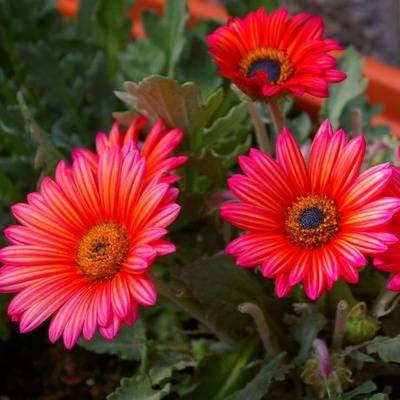

- The hybrid is distinguished by red-orange flowers (Harlequin Mixed) or dark pink inflorescences (Wine). The stems grow to a height of 30-45 cm. Hybrid Arctotis with semi-double petals look very elegant;
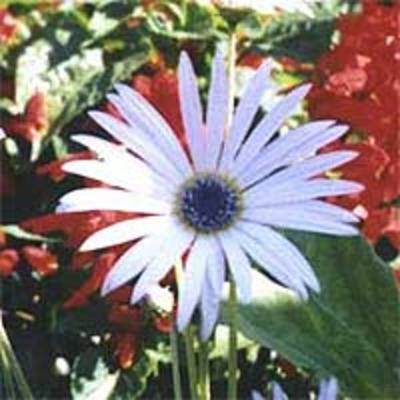

- The stechastolic variety can be attributed to the most common. On stems about 70 cm high, flower baskets with a diameter of about 8 cm grow. This Arctotis stands out for its bicolor inflorescences with snow-white petals at the edges and shiny centers of a deep blue hue. It is noteworthy that the garden variety has longer leaves and wider inflorescences than the main species;
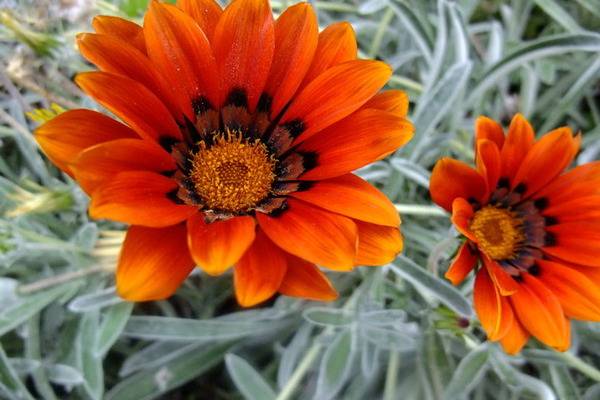

- Arctotis Stem grows no higher than 15 cm. Inflorescences of bright saturated orange shades are formed by reed petals;
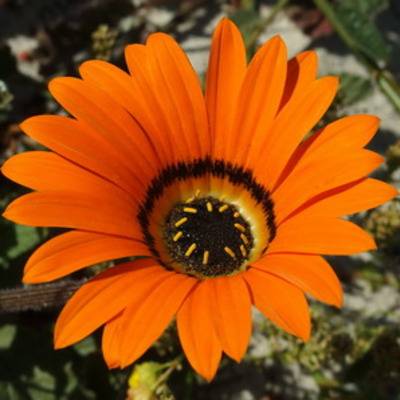

- A stemless plant variety has long (15-20 cm) basal leaves with a green front surface and a white-gray back. Elegant inflorescences of small diameter (about 5 cm) are distinguished by a black-red central part;
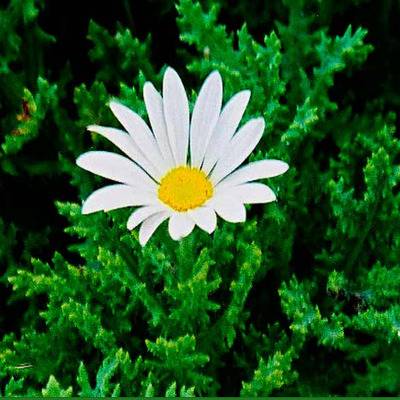

- Rough Arctotis grows no more than half a meter. Differs in yellow reed petals with thin brownish strokes.
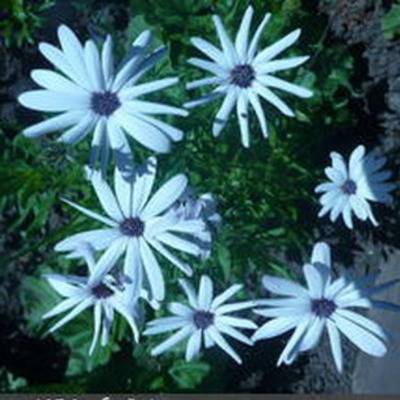

It is impossible not to mention rare varieties: Arktotis Beautiful, short (up to 30 cm) with bluish petals along the edges of the basket.
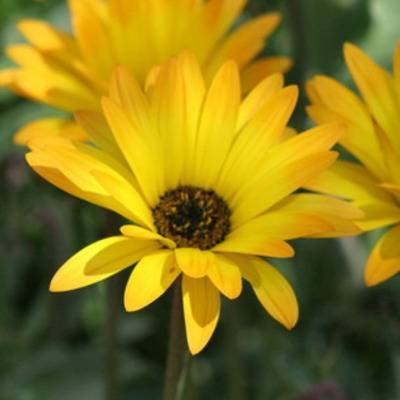

Auricular grows up to 45 cm and has rich yellow marginal petals.
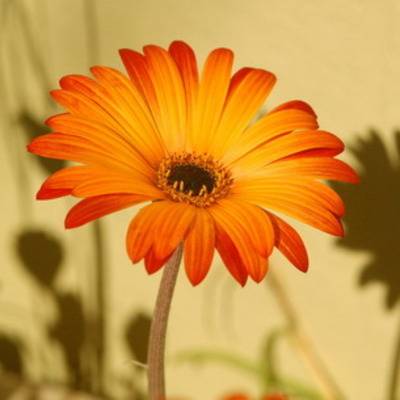

The Arctotis Magnificent flower is remarkable for its large orange petals at the edges of the flower basket.
Reproduction and collection of seeds of arctotis
This flower can be safely attributed to the group of the brightest, most beautiful plants. It is not surprising that gardeners everywhere want to have a collection of these beautiful flowers on their site, garden. In addition, they are completely unpretentious in matters of care and feeding, perennial species are able to endure the cold season, after which they continue flowering even better.
Before the onset of frost, the question of the reproduction of this plant becomes relevant, especially for annual species. The most common and effective way is with seeds. You can also transplant a plant from the ground into a pot. However, the delicate, fragile root system requires proper handling when changing location is necessary. Such a transplant, in the absence of minimal experience, can easily lead to the death of a beautiful flower.
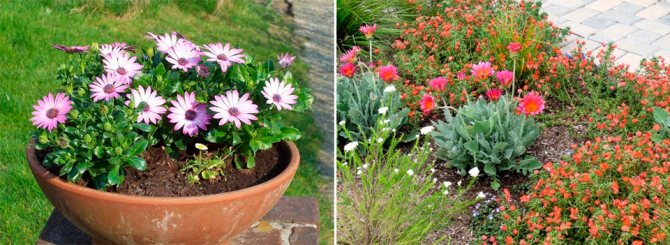

After 2 weeks, as the flowering period ends, a so-called "fluff" forms in the very center of the flower basket. It is a ripe seed and is also the first sign that you can start harvesting seeds. Kon is very large - 1 gram can easily contain up to 500 copies. It is recommended to harvest it exclusively in the morning, while dry weather should prevail.
The collected seed material must be dried as thoroughly as possible, after which they are corked in a special container, where they are already stored until the heat comes next year. There is no need to fear for the safety of seeds, they are able not to lose their properties for up to 2 years, without any negative consequences, the occurrence of diseases.
Growing flowers arctois harlequin and other varieties
Despite the fact that many varieties of arctotis are perennials, in our conditions gardeners prefer to grow this plant as an annual. Although especially valuable specimens for the winter can be successfully planted in pots, for example, on a glazed loggia.
Arctotis naturally grows at the foot of the cliffs in the hot climate of South Africa. Its thick taproot draws moisture from rocky soil as well as any succulent, and its pubescent leaves do an excellent job with the scorching sun.
When growing arkotis, harlequin and other varieties for plants choose a cozy place in a rock garden, although it will grow in a flower bed with no less success. The main condition when choosing a place to grow arkotis flowers is good lighting. Arctotis is not particularly picky about the soil, but it prefers light, limy, well-drained more: on heavy soils, with stagnant moisture, it is also affected by rot. This plant can be used in mixborders and in the design of mono flowers. White-pubescent leaves of low-growing varieties look spectacular along the borders and in the background in the ridges. Arctotis grows well in boxes on the balcony or open veranda.
Diseases
... With excessive moisture, arctotis is susceptible to fungal infections. Pests bypass him. But in the case of the appearance of spotting during the cultivation and care of arkotis, the plants must be treated with a fungicide.
Diseases and pests of arctotis
Arctotis, like all plants, is vulnerable to certain diseases, plant ailments. The most common problems with this flower are meadow bugs and aphids. At the first signs of damage to the plant, insecticides are immediately used. An excellent remedy for bedbugs is a mustard-based water solution. Such a solution is prepared at the rate of 100 grams of mustard powder per 10 liters of water.
Of the diseases, arctotis suffers from gray rot. Formed by excessive watering. Does not respond to treatment.
To prevent the appearance of ailments, it is necessary to inspect the seedlings daily for plaque, holes in the leaves.
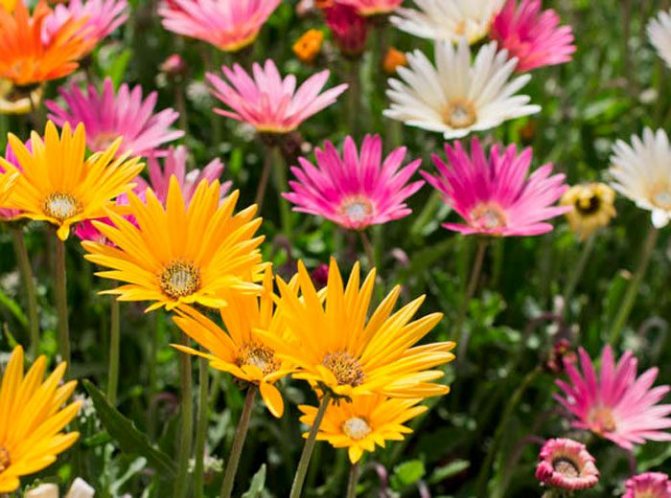

The flowering plant Arctotis is a member of the Astro family. This genus unites about 70 species.Some of these species are considered endemic to the Cape region, about 30 are found in Africa south of Angola and Zimbabwe, and another part grows in South America. The name of this plant is translated from Greek as "bear's ear", this is due to the fact that the bush has a very dense pubescence. Arctotis has been cultivated for over a century.
Plant features
The Latin word arktotis translates as a bear's ear. It would seem that what is common between a delicate flower and a wild beast? Take a closer look at the photo: the deep dark center and dense edge of the petals really looks like a round bear's ear.
Akrtotis - a bright decoration of a flower bed
Inflorescence baskets have a wide range of petal colors - they are white, flying, orange, red, crimson, blue, lilac. Large saucers of flowers about 5-8 cm in diameter.
Reference. Photo of red flowers can be easily confused with gerbera, but arctotis gives out a special shape of wavy-toothed incised leaves.
Petunia, nasturtium, godetia, Drummond phlox will become good neighbors in the flowerbed for arctotis. The flower is grown not only in flower beds, but also on rocky hills, used in mixborders. Arctotis in bouquets is attractive.
Features of arctotis
In nature, arctotis is represented by shrubs and herbaceous plants. On the surface of foliage and shoots there is a dense pubescence of white or silver color. Alternately or oppositely located leaf plates have a wavy or notched-toothed shape. Saucer-shaped inflorescences-baskets in diameter reach 50-80 mm, outwardly they are very similar to chamomile or gerbera. Single flowers are located on long peduncles, they include marginal ligulate flowers of purple, yellow, white or pink color, as well as tubular median flowers, painted in purple, purple or brown. The composition of the multi-row inflorescence wrapper includes many scales. The fruit is a brownish-gray seed with a tuft. The seeds remain viable for 2 years.
Arctotis is a perennial, annual and biennial. Perennial species in regions with a relatively cool climate are grown as annuals.
Botanical description
These are annual, biennial and perennial herbaceous or semi-shrub plants. Arctotis leaves are opposite or alternate. The inflorescence is in the form of a basket. The color of flowers is very diverse: they can be white, pink, scarlet, yellow, orange. The fruit is a grayish brown achene containing many small seeds.
Inexperienced gardeners may confuse arctotis with as they do look alike.
Did you know?
The Latin name for the flower "arctōtis" comes from the Greek "arktos" - "bear" and "otos" - "ear". That is, the literal translation is "bear's ear". The flower got its name due to its pubescent fleshy leaves and stems.
Planting arctotis in open ground
Growing arctotis from seeds
Arctotis can be grown from seed and is best done through seedlings. Growing seedlings of such a beautiful flower is quite simple. It is recommended to sow seeds in mid-March, for this they are laid out in peat pots of 3-5 pieces. Take a pallet and place all the pots there, which then need to be covered with glass or film on top. The first seedlings will appear after about 7 days. It is not recommended to grow seedlings of this culture in a common container, since it tolerates picking extremely poorly. But if, nevertheless, for sowing, for example, a box was used, then the seedlings during the formation of 2 true leaf plates will need to be cut into pots, while 3 plants are planted in each. After the height of the seedlings reaches 10-12 centimeters, they should be pinched to make the bushes more lush.
Seedlings are planted in open soil only when the threat of return spring frosts remains behind, as a rule, this time falls on the second half of May or the first days of June. Before starting planting, the plants must be hardened so that they can get used to the new conditions. To do this, the seedlings should be transferred every day to the street, while the increase in the duration of this procedure should be gradual. It should be noted that after 15 days of hardening procedures, the seedlings should be able to remain outside around the clock.
Planting holes must be made keeping a distance of 0.25–0.4 m between them. In them, you need to carefully cross the plant, while trying not to destroy the clod of earth. In the event that the seedlings were grown in peat pots, then they should be planted together with these containers. The holes should be covered with soil, the surface of which should be slightly compacted. The planted plants need abundant watering.
How to plant arctotis in the garden
In regions where spring comes relatively early, and it is quite warm, it is quite possible to sow arctotis seeds in open soil in the first days of May. This culture is distinguished by its photophilousness, in this regard, the site should be open and sunny. Suitable soil must be well-drained and must contain lime. This plant is not recommended for growing on clay and damp soil. During sowing, 4 or 5 seeds should be placed in each well. The distance between the planting holes is strongly influenced by the species and variety of arctotis grown. So, between tall plants, a distance of at least 0.4 m should be observed, and between undersized plants - about 0.25 m. After the seeds are sealed, the surface of the site needs to be tamped a little, then it is well watered. The first seedlings can be seen after about 10 days, and after only 10-12 days they are thinned out. If the plant is properly cared for, it can start blooming after 8 weeks.
Care features
In order for the plant to bloom for a long time and abundantly, well-lit places, protected from the winds, are distinguished in the summer cottage for planting flowers Arctotis. The plant prefers light, drained soils and does not develop well on constantly damp soils. Also, the flower reacts negatively to the introduction of fresh organic fertilizers into the ground.
Moreover, the low-growing Arctotis flowers are placed according to the 25x25 cm scheme, and the tall ones - 40x40 cm. Since the plant forms a long and powerful central core, the seedlings can be transplanted only once.
Since in natural hot conditions the flower grows on stony soils, it does not need abundant watering. The main requirement when choosing a place for planting Arctotis flowers is open areas.
It is recommended to use mineral compositions (phosphoric) in small quantities during the flowering period of Arktotis. It is better to add nutrient solutions while watering the bushes.
After watering, it is recommended to loosen the soil and remove weeds. To stimulate lush flowering, it is recommended to constantly remove faded baskets. It should be borne in mind that high grades may need additional support.
Since Arktotis flowers are not left for wintering in the middle / northern regions, the bushes are pulled out and burned in autumn. It is easy to stock up on planting material yourself. To do this, you need to observe the faded inflorescences. After about one and a half to two weeks, wilted baskets are covered with a fluffy layer. It is necessary to cut them off and dry them in a cool dry place. The seeds are cleaned from baskets and packed in thick paper bags.
Caring for arctotis in the garden
It is quite simple to care for the arctotis grown in the garden, you just need to water it in a timely manner, weed, feed it, loosen the soil surface, pinch it, and also treat it from pests and diseases, if the need arises.
This culture is highly resistant to drought, the root system of the bushes is able to extract moisture from the deep layers of the soil. In this regard, arctotis does not need frequent watering. However, during a prolonged drought, it is still necessary to water it from time to time, especially when you consider that it is much easier to loosen and weed the moistened surface of the soil.
Mandatory feeding for this plant is not needed. However, during the formation of buds and flowering, the bushes are still recommended to be fed with complex mineral fertilizer. Organics are not used for feeding this culture.
Still do not forget, timely remove the baskets that have begun to fade, which affects the more active formation of new buds. Often tall bushes need a garter to support.
Diseases and pests
This crop is highly resistant to diseases and pests. However, meadow bugs and aphids can still settle on the bushes. If arctotis is planted in wet soil, as well as during prolonged rains, the likelihood of developing gray rot is high.
To eliminate meadow bugs, the bushes must be treated with a mustard solution (for 1 bucket of water 100 grams of dry powder) or onion infusion. If necessary, the treatment can be carried out with an insecticidal preparation. Aphids are a sucking insect that feeds on plant sap, and it is also one of the main carriers of viral diseases that are considered incurable. To get rid of it, you should use insecticides, for example: Aktellik, Fitoverm, Aktara, etc.
If a bush is damaged by gray rot, it must be removed from the soil and destroyed, since such a disease cannot be cured. The remaining bushes must be sprayed with a fungicide solution, for example, Fundazol.
After flowering
Plants grown as annuals, after they lose their showiness, are dug up and burned. And with the onset of autumn, you need to remove plant residues from the site, and then dig it up. In regions with a cool climate, all arctotis species are cultivated as annuals. In the southern regions of Russia and Ukraine, it is quite possible to grow perennial species of this plant, but only for the winter they need to be very well covered. In late autumn, you should cut off the part of the bush that is located above the ground. Then the surface of the site must be mulched with a thick layer of bark, straw or sawdust, the flower garden is covered with a non-woven material or spruce branches on top.
Further care
Caring for arctotis is not difficult - it is frequent loosening of the soil and regular moderate watering. In order for the bushes to develop better and be more lush, they must be pinched.
Important. You cannot fill the flower, its root system is deep enough and is designed to absorb moisture from the ground.
Arctotis is an annual or biennial plant with fairly large bright flowers, which belongs to the Asteraceae family. Today there are over 30 different species of this plant, which is native to South Africa. The main differences between the different varieties of arctotis are the size and shape of the flowers.
Types and varieties of arctotis with photos and names
In the middle latitudes, not very many species of arctotis are cultivated.
Arctotis short-stemmed (Arctotis breviscapa)
This perennial plant is a compact bush, the height of which does not exceed 15 centimeters. The homeland of this species is South Africa. On the surface of shoots and leaf plates, there is a white tomentose pubescence. Marginal ligulate flowers are colored deep orange. Cultivated since 1812
Arctotis rough (Arctotis aspera)
The homeland of this species is also South Africa. The height of the bush varies from 0.4 to 0.5 m. In middle latitudes, this species is cultivated as an annual. The diameter of the inflorescences-baskets is about 50 mm, they include tubular yellow flowers and yellow ligulate flowers with brown streaks.
Arctotis stemless (Arctotis acaulis = Arctotis scapigera)
This species is a perennial and has a strong taproot. The length of the pinnately dissected leaf plates is about 20 centimeters, their front surface is green, and the back is whitish, because there is pubescence on it. Baskets reach about 50 mm in diameter, they include reed flowers of yellow color with a purple lining, as well as tubular flowers of red-black color.
Arctotis stoechadifolia
This species is also from South Africa. This perennial plant is cultivated as an annual in mid-latitudes. Strongly branched greenish erect shoots are about 100 cm high, and their surface is covered with pubescence, consisting of a soft bristle of white-silver color. Asymmetrical dense sheet plates have a lanceolate-oval shape, their edge is serrated-wavy. They are opposite, and on their surface there is a tomentose pubescence. The lower leaf plates are petiolate, and the upper ones are sessile. On long peduncles, single graceful inflorescences are located, their smell is rather weak, but very pleasant. They include marginal flowers of a snow-white color, and their bases are yellow-golden, while their lower surface is light purple. They also consist of small tubular flowers of a violet-gray color, in the middle of the basket they form a bluish-steel disc. On a cloudy day, the inflorescences close. It has been cultivated since 1900. There is a variety of grandis: unlike the main species, its leaf plates are longer, the baskets are also larger.
Arctotis hybrid (Arctotis x hybridus)
This species combines complex hybrids that are popular with gardeners. They are obtained by crossing different species of arctotis. these hybrids can be grown both as annuals and as perennials, it all depends on what the climate is in your area. Not very often, gardeners cultivate such species as: auricular arctotis - the color of reed flowers is rich yellow; beautiful - the edge flowers are blue; lush, or gorgeous - with large orange marginal flowers. The most popular varieties are:
- Pink Suga... The marginal flowers are orange-yellow from the middle to the base, and lilac-pink from the ends to the middle.
- Mahogeni... The tubular flowers are green, and the marginal ones are orange-terracotta.
- Hailey... The color of the reed flowers is bright yellow, and the middle includes black and dark yellow cylindrical circles.
- Brick Red... The color of the reed flowers is red, and the middle is dark brown-yellow.
Also in the culture, the Harlequin variety mixture is quite popular, which includes varieties of various colors.
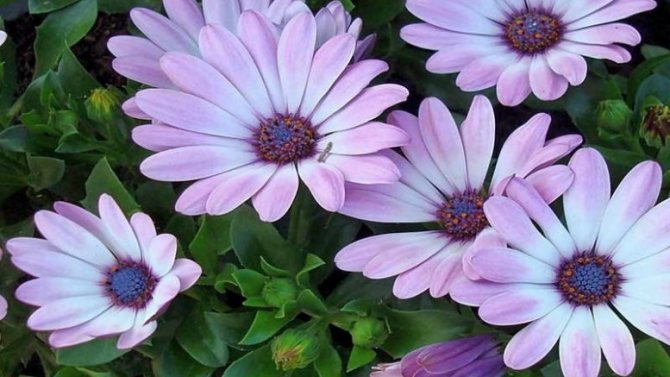

Arctotis flowers rightfully belong to one of the brightest representatives of garden plants. Along with luxurious looking dense greenery, they have gorgeous inflorescences.
Unfortunately, Arktosis is now rarely seen in flower beds and private garden plots, although they have been cultivated by humans for a long time. We sincerely hope that this situation will improve in the foreseeable future, and these beautiful flowers will be able to gain well-deserved popularity among gardeners. After all, arctotis are unpretentious, hardy and at the same time incredibly aesthetic and decorative.
Varieties
Currently, about thirty species of arctotis are known.
Arctotis stemless
Which one will grow on your personal plot - a perennial or annual flower - depends on the variety chosen by the florist, the method and place of cultivation:
- Arctotis stemless is a perennial flower that is grown in the middle lane as an annual plant. Has purple, crimson petals. The feathery gray-green leaves are whitish on the underside. The flowering period is from mid-summer to September.
- Arctotis hybrid is a spectacular bright perennial plant.Baskets of inflorescences up to 10 cm in diameter, semi-double flowers of saturated colors - yellow, orange, lilac with a contrasting center. The petals are dissolved exclusively on sunny days. In horticultural culture, it is grown as an annual flower. Bloom - from July to early autumn.
- Arctotis short-stemmed - undersized biennial, up to 15 cm tall. This variety is distinguished by its orange flowering. For the winter, this garden culture is not left in the open field.
How to plant arctotis seedlings or sow seeds in the ground
Seeds for growing Arctotis can be easily purchased at flower shops, or you can collect them on your own plot. The seeds of these flowers reach their ripening period approximately two weeks after flowering. The seeds of Arctotis are very small in size, so it is important not to miss the period of their collection, otherwise you risk losing them if you do not collect them in time. You can collect them in reserve, as the seeds of Arctotis remain viable for up to two years.


arctotis hybrid harlequin growing from seed
Usually these flowers are grown in seedlings., and in warm climates, arctotis from seeds can be grown immediately in the open field.
- To grow seedlings, you will need to pre-sow seeds in a container with a peat-sand mixture in March.
- You can also treat the soil with a solution of potassium permanganate. This will help keep the seedlings free from unwanted infections and pathogens.
Arctotis growing from seeds video:
Growing seedlings at home is quite simple:
- Arctotis seeds must be scattered over the surface of the soil., cover with glass or some kind of film, then place in a warm place (the temperature should be about 22-24 degrees Celsius). The first shoots should appear in a couple of weeks.
- When the first shoots finally hatch, your impromptu tiny "greenhouse" can be opened. Watering is best done with the "bottom" method, through the pallet. Spraying seedlings is not worth it, this can disrupt the course of its growth. After your seedlings are still growing, it will be necessary to thin them out.
- After the appearance of full-fledged leaves, all seedlings are usually transplanted in separate pots., or 2-3 seedlings in one pot. At the same time, be extremely careful, since only ascended Arctotis have an extremely fragile and delicate root system. It is necessary to carefully and carefully transplant so as not to damage young plants.
- Transplantation, which is traumatic for a plant, can be avoided if the seeds are initially planted in peat tablets. And when the seedlings reach about 10 centimeters in height, they are pinched to increase bushiness.
If you are sowing seeds in a mild warm climate directly into the ground, then you can start sowing in April.... Several seeds should be planted in one nest, leaving a distance of 20-40 centimeters between them, and after the sprouts appear, it is also necessary to thin out.
Planting seeds
You can grow a flower by sowing seeds in open ground or planting seedlings. The seeds of Arctotis are usually quite small in size, with a slightly pubescent brownish surface. In open ground, the seed is sown in the first half of May.
Sowing stages
Growing seedlings of Arktotis is the best option, and it is better to sow seeds in late March or early April.
- Since the tap root system of plants is quite long, the seeds are sown in separate specially prepared containers so as not to damage the roots when planting Arctotis sprouts. You can use a nutritious potting mix available from flower shops. Or prepare the soil yourself - mix in equal proportions sand, garden soil and peat. To disinfect the soil, it is recommended to pre-calcine it in the oven.
- In containers, make holes in the center of the moistened nutrient mixture and put 2-3 seeds of Arctotis (in each glass).
- The wells are carefully sprinkled with earth and additionally moistened (you can use a spray).
- To prevent the soil from drying out, cover all containers with glass or plastic wrap. Suitable conditions for emergence are a warm and well-lit area.
Arctotis planting and care in the open field with a photo
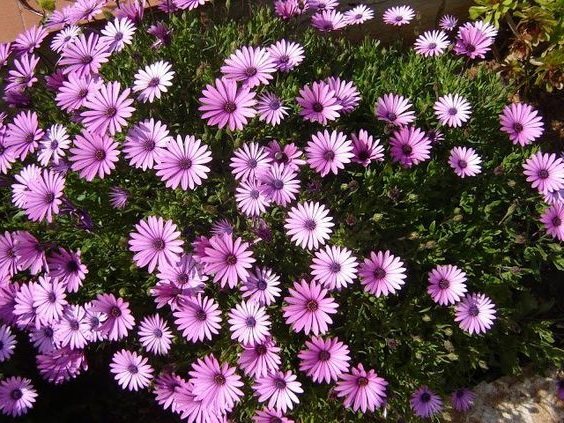

arctotis photo cultivation
You can transplant your pre-grown seedlings into the ground at the end of spring., when the danger of any frost has completely passed. It is important to remember that Arctotis are very light-loving flowers. Therefore, before sowing, make sure that the area in which they will grow is not deprived of the attention of the sun.
Flowers of Arktosis will certainly endow you with their luxurious inflorescences. Plants are not particularly whimsical to soil and are able to grow in almost any land, with the exception of clay soil, which will be difficult for sensitive plant roots to cope with.
Arktosis will feel most comfortable if there is a sufficient amount of sand in the soil., which can ensure its effective drainage - another condition for the favorable development of these plants.
Watering
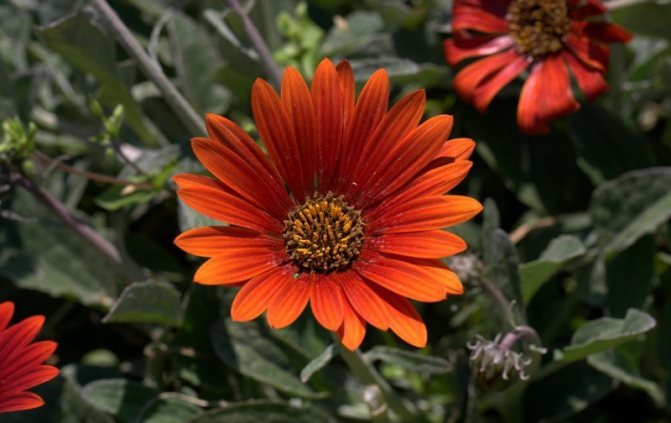

flower arctotis planting and care
First of all, after providing plenty of sunlight, Arktosis needs proper, moderate watering. It is highly discouraged to water it too often and vigorously. Abundant watering can cause the development of root rot and, as a result, destroy the plant.
It would be preferable to slightly dry the soil than to overmoisten it.
This nature of the plant is due to the natural conditions of its homeland, South Africa, where the plant most often grows in rocky soil and in dry weather.
Thanks to this, the plant has the ability to draw moisture from the depths of the soil using its elongated roots, which allows Arktosis to maintain a fresh appearance even in the hottest weather. But the weeds of Arktosis are not friends at all, therefore, after watering, it is strongly recommended to inspect and cultivate the soil to free it from weeds.
Top dressing
Before the Arktosis begin to bloom, it is advised to feed them with a solution of mineral fertilizers. At the same time, remember that organic fertilizers can, on the contrary, only harm your flowers.
Flowering features
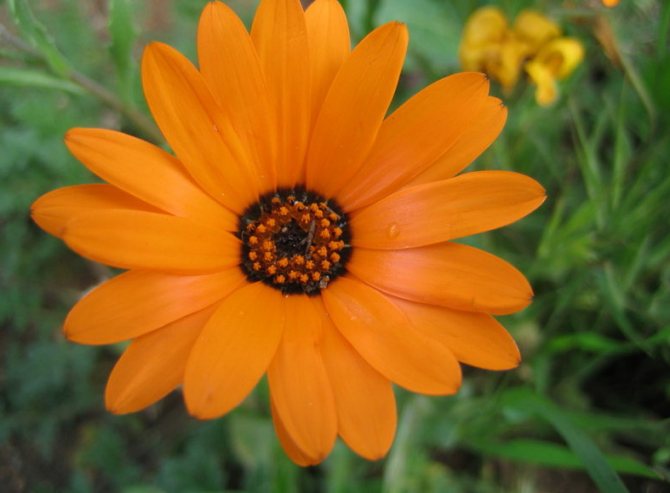

arctotis outdoor herbaceous plants
It is best to remove faded flower heads in a timely manner, this will help preserve more nutrients for live flowers and generally extend the flowering period.
Reproduction
- Arktosis is very difficult to preserve through the winter until spring, so the only way for them to reproduce is with the help of seeds. Of course, you can plant a flower from the ground and, by transplanting it into a pot, keep it at home, however, the fragile root system of Arktosis is very sensitive to such transplants, they can lead to the death of the flower.
- A couple of weeks after the end of flowering, a fluff will appear in the center of the remaining basket - this is a ripe achene, and also a signal that it is time to start collecting seeds. Their concentration is unusually high. 1 gram can contain up to 500 seeds. Harvesting is best done in the morning in dry weather. The collected seeds are carefully dried, corked in a separate container and stored until next spring.
Possible care problems
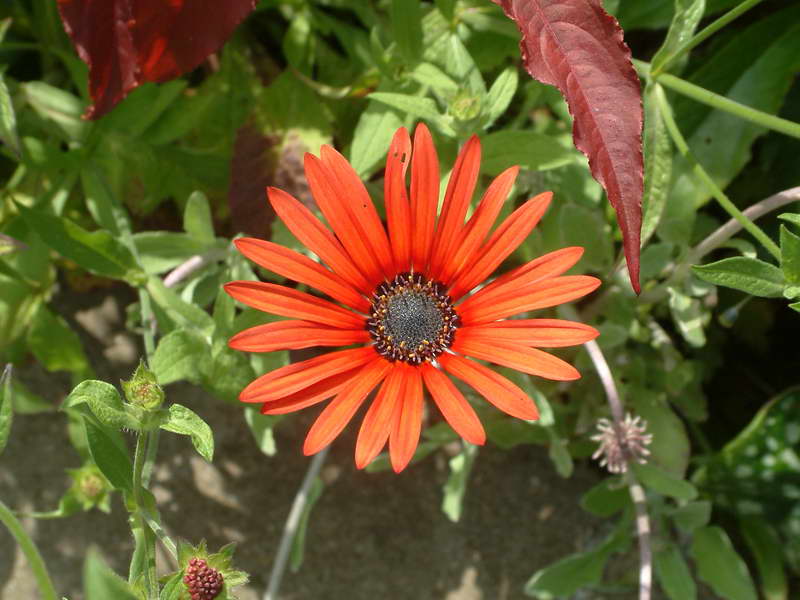

arctotis flower photo
Arktosis is vulnerable to parasites such as aphids and meadow bugs. When signs of infection from aphids appear, insecticides can protect the plant, and a simple solution of mustard-based water will help to cope with bugs (only 100 grams per 10 liters of water are needed).
Arktosis are able to decorate any flower bed in any garden.They are unpretentious and hardy, you just need to provide these plants with sunlight and moderate watering, and they will delight you with their luxurious floral decoration for a long time.
Compositional combinations and the role in landscape design
Great combinations of arctotis are obtained with godetia, fuchsia and marigolds. The bear ear has become widespread in landscape design. It looks great both in single plantings and in compositions on flower beds, mixborders and borders.
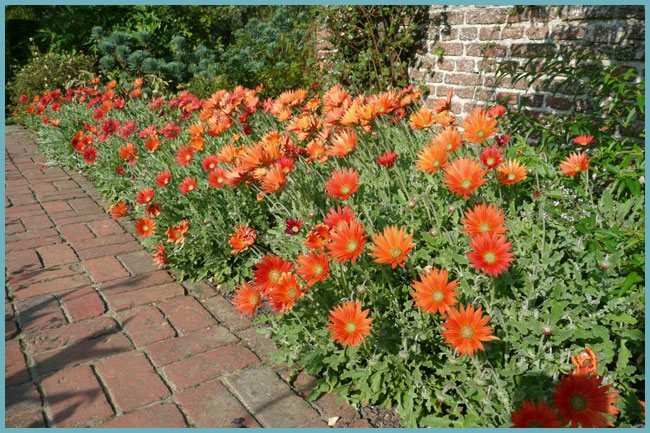

Arctotis in the summer cottage
Arktotis is an annual outdoor plant in Russian summer cottages. Simple but very beautiful flowers. The ease of care and cultivation made it a valuable specimen among those who do not have the opportunity to pay constant attention to the plant. Growing from seeds is a quick way to get this South African beauty.
Problems and illnesses
Most of the problems in caring for arctotis are associated with waterlogging. Due to excessive soil moisture, the root system can be rotted. In this case, all terrestrial organs will look attached, the buds may stop developing and dry out. With such a picture, the bear's ear should be dug out, all damaged roots should be cut off and planted in dry soil. If the root system is severely affected, then it is better not to try to save the flower, but to burn it so as not to infect the entire soil.
Another disease that can appear when grown in dampness is leaf spot. To combat it, apply abundant spraying with garden fungicides, for example, Bordeaux mixture.
Sometimes arctotis suffers from parasitic insects such as bugs or aphids. Insecticides will help in the fight against insects, with which the plant must be treated at least three times with an interval of seven days.
Arctotis in the photo
Sowing arkotis flowers for seedlings
To sow arctotis for seedlings, you need to collect them from a flowering plant 2 weeks after the inflorescences wilted, when the fruits are formed - grayish-brown pubescent achenes. For seedling cultivation at the end of March, Arctotis seeds are sown in small boxes in a heated greenhouse. On the 8th - 10th day, seedlings appear, which grow unsupportedly and slowly. The grown seedlings are slightly thinned out, watered moderately, do not spray.
After planting the arctotis, the pick is made after 3 weeks, 2 - 3 pcs. in separate peat pots. Seedlings with a height of 10 - 12 cm are pinched and planted in a permanent place in the second half of May according to the scheme 25x25 cm for low-growing varieties or 40x40 cm for tall ones.
If the seedlings do not dive into peat pots, then the planting of plants is carried out by the transshipment method, without disturbing the clod of earth. In arctotis seedlings, the root system is very sensitive and any violation of it strongly affects the further development of young plants: they can lag behind in growth and even die. Therefore, if possible, it is recommended to immediately sow seeds in separate pots and grow seedlings without picking. After planting arkotis, with proper care, seedlings in the open field grow quickly and delight with abundant flowering until autumn.
Growing arctotis from seeds
A native of Africa who moved to Europe and America, the flower that conquered gardeners of all continents is arctotis. It, outwardly somewhat reminiscent of a star, is often confused with gazania, mini-aster or daisies. This is not surprising, all these plants are close relatives.
Arctotis can be called a plant for lazy people - it is unpretentious, grows easily, does not need constant fertilization and watering. If you find a suitable place for him, then he will delight with his magnificent flowers and next to other representatives of the flora, and growing far from them.
Taxonomy and names
Arctotis belongs to the Asteraceae family, from the Dicotyledonous class of the Angiosperms (Flowering) division.The scientific Latin name for the genus Arctotis was given by the Swedish taxonomist Karl Linnaeus. The name still causes some bewilderment and a number of jokes about the stupid imagination of the scientist, because in translation "arktotis" means "bear's ear". However, no part of the plant is shaped like a bear's ears. Most likely, the association was caused by the pubescent leaves of some arctotis species. The name "bear's ear" is also found in Russian, as a literal translation of the scientific name.
Popular names "African chamomile", "African daisy" are associated with the natural range of the plant.
Do not confuse "bear ear" with the similar name "bear ears", that is, with bearberry belonging to the Heather family. These two different plants are completely different from each other, grow in different geographical latitudes and in different biocenoses.
Morphological characteristics


Among the species of arctotis, there are various life forms: perennial herbaceous, dwarf shrubs, biennials and annuals.
Arctotis can grow as a ground cover plant, with short stems, or reach a height of half a meter or more.
Leaves are simple, feathery. The leaf blade is of varying degrees of dissection, pubescent on both sides, so the leaves of some species appear silvery. In other species, the dorsal side of the plate is bright green, and the lower surface is light green or white. The hairs protect the leaves from the sun's rays on the one hand, and from the cold on the other (in the daytime and at night, in places where arctotis grows, the temperature can fluctuate greatly).
Very small flowers of two types - tubular and false-ligulate, collected in a basket of inflorescences. The marginal flowers, popularly called petals, are sterile and have the function of attracting insects and protecting them. The middle flowers are five-membered, actinomorphic (with radial symmetry), have stamens and pistil, and form seeds.
The color of arctotis inflorescences can be of any color and shade - from white or cream to maroon. But most often the color is yellow. Flowers are pollinated by insects.
Plants have a pronounced "love of the sun" - in the evening they close their inflorescences, and when the sun rises, they open again.
Growing features


Lighting
All species of arctotis love good lighting, preferring to grow in sun-drenched flower beds and flower beds. Born in Africa, arctotis are not afraid of the direct rays of the European sun, their leaves are protected from ultraviolet radiation. In the sun, arctotis grows rapidly and blooms profusely. Grown in partial shade with a lack of lighting, arctotis will not look so impressive, the number of inflorescences they will be much less, or the plant will not bloom at all.
Substrate
Well-drained and well-aerated substrates are optimal for arctotis. Arctotis does not grow on acidic soils with a pH below 6.0, but it can grow on calcareous soils. The plant does not like heavy clay substrates. Before planting arctotis, such a soil must be changed by adding sand and compost to it. For an adult arctotis, as well as for growing its seeds and seedlings, an identical soil is suitable.
Humidity and watering
Arctotis does not like stagnant water in the soil and excessive watering. When the air temperature drops, watering must be reduced or stopped, otherwise it will cause the development of fungal infections. When watering, you need to try to get less water on the leaves and flowers. Water the arctotis, preferably in the morning.


Fertilizer
Usually, arctotis is fertilized with complex fertilizers at the beginning of the growing season. It is best to do this before flowering. It is important not to overdo it with fertilizers, as an excess of mineral components can have negative consequences. For example, with an excess of nitrogen, arctotis will give a large green mass, but few flowers. Excess fertilization can be one of the causes of arctotis disease (for example, root rot).
Seed propagation
Since annual arctotis species are more often used in culture, they are propagated mainly in a generative way, that is, by seeds. Arctotis seeds can be sown immediately after ripening, or after a few months - they do not lose their germination for 2 - 3 years, depending on the species and variety.
River sand or perlite should be added to the seed soil to make the substrate breathable. You can sow seeds in pots, special seedling cassettes or a pallet. Wooden boxes with low sides can also be used. Their bottom should first be covered with foil.


As a mixture you can use: peat + perlite / sand in a ratio of 1: 1; peat, deciduous forest soil + perlite / sand in a ratio of 1: 1: 2; black earth + perlite / sand in a 1: 1 ratio. You can use summer cottage soil (if it is not very acidic) or universal soil sold in stores. When using soil from the street, before planting, it must be calcined in the oven in order to kill pests, their larvae and eggs.
The seeding depth for planting in closed ground is 1 - 2 cm, in open ground 2 - 3 cm.
When sowing, the soil should be well moistened, but not wet. After sowing, the container with seeds is covered with a film so that it does not come into contact with the soil surface.
Seedlings appear in 1 - 3 weeks. After that, the film is either removed or raised higher by 30 - 40 cm above the ground level. It is imperative to make holes in the film for air exchange.
Seeds are sown at the end of February - March, depending on the climatic conditions of the region. Ready seedlings are planted in a permanent place in April-May.
Sowing seeds outdoors is possible in areas with warm climates. It is held in late April - early May.
Another "chamomile" plant that can decorate the garden is arctotis. This plant is related to such flower bed stars as sultry Gaillardia, luxurious gerbera or charming osteospermum. Of course, the wealth of the Aster family, which includes more than 20 thousand plant species, is not limited to these garden representatives. For example, recently we talked about Venidium. Today we will talk specifically about the arctotis.
In the title photo, the Flamingo variety.
The name Arctotis (Arctōtis) translated from Latin means "bear's ear", and this name it received not because of the flowers, but thanks to the pubescent fleshy stems and leaves. Even without flowers, the plant looks attractive and noticeable.
Inflorescences-baskets with silky petals of white, yellow, bright orange pink or red. The tubular flowers in the center are either purple-gray or brown. The flowers are quite large, in some hybrid varieties - up to 10 cm in diameter.
Can arctotis flowers be confused with gerbera? The flowers are very similar indeed. But the flowers of the gerbera are always open, in the arktotis they close at night and in cloudy weather.
Homeland - South Africa, habitat - the foot of the rocks, dry and hot air. The root is thick, taproot, designed to extract moisture from the scanty stony soil. Thick silvery hairs on leaves and stems protect delicate tissues from the scorching sun.
general description
In natural conditions, arctotis is endemic, since it is found only in one place on Earth - in the Cape region of Africa. Its favorite habitats are rocky slopes and soils, where the conditions for survival are rather harsh and limited. With all the problems of dry and hot regions, the bear's ear copes well and grows in one place for several years in a row, but when trying to acclimatize wild forms in other climatic zones, the cold becomes the main limiting factor. Therefore, cultural representatives are grown mainly as annuals.
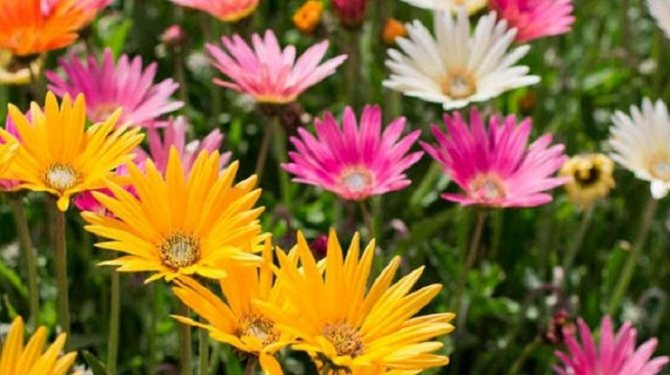

Natural specimens grow in the form of herbaceous plants or small dwarf shrubs.The soft leaves can be covered with numerous bristles, which make the foliage look whitish or silvery. The edge of the leaves can be straight or split. Peduncles rise several centimeters above the bush, usually the buds are located singly. The color of the petals can be white, pink or yellow, and the palette of cultivated varieties is much wider. After flowering, the fruit is formed in the form of an achene, which retains good germination for two years.
A characteristic feature of the bear's ear is long and abundant flowering, which can begin in June and end only with the onset of the first frost. As a rule, the first inflorescences are larger and brighter than those that form at the end of the season.
Plant overview on video
Audio article in the blog "Alexandra".
The second name for arctotis is the bear's ear. Why exactly this? The plant got its second name due to excessive pubescence, which has a silvery-white tint. Its inflorescences are somewhat similar to a gerbera, and reach about 6 centimeters in diameter, stand on a very long peduncle. They take on both white and pink, purple and yellow hues, as you can see in the photo below. The inner part of the flower is brown, purple or violet in color. Her basket wrapper is multi-row and consists of a huge number of scales. The seeds of the flower are grayish brown.
Arctotis orange
The homeland of arctotis is South Africa, which serves as a kind of tip for gardeners who decide to decorate their site with this plant. Despite the fact that his homeland has a very hot climate, the flower always looks fresh and beautiful. Therefore, many gardeners choose it for the decoration of their personal plot, both as single plantings and in flower beds. The flowers retain their fresh appearance thanks to the taproot, which absorbs moisture both from the surface and from slightly more stale soil layers.
For planting this plant in your area, it is better to choose sunny places. In no case should it be fertilized with fresh organic fertilizers, as well as moist soil. This flower prefers light, well-drained, lime-containing soil more. Therefore, planting it is possible only in such soil. Growing and caring for him will not be difficult for an ordinary gardener, since everything is as easy as shelling pears. Its cultivation needs weeding, loosening of the soil, as well as watering in dry times.
Arctotis varieties
Today, about three dozen varieties are known to gardeners. Let's consider a few of the most popular ones.
Hybrid
This variety is a perennial plant, however, its cultivation is the same as for annuals. From its flowers, semi-double baskets can form, which reach up to 8 centimeters in diameter. Reed flowers acquire a yellowish, reddish, orange or lilac shade with the effect of a dark, purple or brownish-violet tint in the middle. They begin to bloom only on sunny days from the first days of July to September. You can look at this flower variety in the photo below.
White arctotis
Acaulescent
It is a perennial that is grown as an annual flower. You can see this plant in the photo below. The flowers are about five centimeters in diameter. They acquire a yellow reed and black-red tubular color. It has a very thick and at the same time taproot. The leaves located near the roots reach up to 18 centimeters in length, they are pinnately dissected, green above, and whitish from the lower area. One can enjoy beautiful flower dissolutions from early July to late September.
Short-stemmed
This variety is a rather low perennial flower.The cultivation is the same as for a regular annual or as a biennial. In growth it reaches approximately 14 centimeters. The leaves are white-tomentose. And the reed flowers have a bright orange color. Usually it does not hibernate in open soil. You can look at it in the photo below.
Rough
Like all previous varieties, it is grown in the same way, and reaches up to 48 centimeters. Flowers reach up to 5 cm in diameter. The reed flowers are yellow with a brown streak. You can look at this flower variety in the photo below.
Stechasoliferous
It grows in South Africa. It is grown like all the other varieties listed above. The stem is erect, strongly branched, with a light green color. And the hairs are silvery white. At a height of about 100 centimeters. The leaves are oval-lanceolate. They are a little thick, pubescent, like the stems, of an asymmetrical shape. The flowers are located on peduncles, are solitary, up to about 6 centimeters in diameter, with a pleasant aroma.
Arctotis variety
The base of the flowers is golden yellow, and the bottom is pale purple. The areas in the middle are violet-grayish in color. If you carefully examine the flower of this variety, you can see that in the central part of the inflorescence there is an area of bluish-steel color. Dissolved flowers can be seen only on sunny days. For the whole night and on rainy days, the inflorescences close, very moody. Loves only the scorching sun. It begins to bloom in early June and still blooms until November. The seeds can still be planted for three years.
Any of the varieties of arctotis can be used on various rocky hills, in various plantings. It can also be planted near marigolds, godetia, and nasturtium flowers. With the help of white pubescent leaves, it can perfectly decorate a flower bed of bright flowers.
Arctotis can be propagated using seeds. In the last days of March and early April, we plant containers with them. After about 13 days, seedlings become visible. Very early you need to dive seedlings, about nine-centimeter peat-humus pots. Planting should be carried out in open soil in the last days of late May - early June, besides, we pinch the stem in order to get better tillering. If there are no peat-humus pots during transplantation, the taproot may be damaged and the flower may either die or deteriorate badly.
Arktotis is an unusual representative of the South African flora that won the hearts of gardeners more than a century ago. Its unusual complex flowers are painted in the brightest shades and give a mood throughout their flowering. But in order for the arctotis to bloom, it will need a lot of sunlight and painstaking care. You will learn how to care for a plant in this article.
Arctotis is a herbaceous plant or shrub that belongs to the Astrovye family. The official name Arctotis comes from the Greek arktos meaning bear and otos meaning ear. For this reason, the popular name "bear's ear" was stuck behind the arctotis.
|
Where does the flower come from
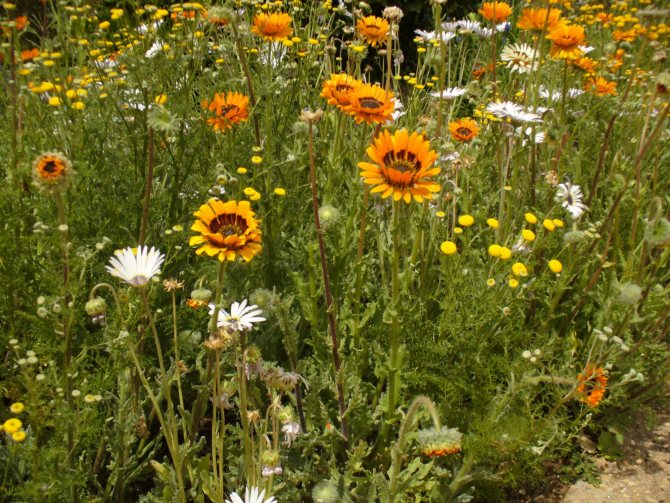

In nature, arctotis is a herbaceous plant
The homeland of arctotis is South Africa, where it grows on rocky slopes. Sometimes found in southern regions of Zimbabwe and Angola on poor soils. Some species grow in the same conditions in South America. Therefore, arctotis can be considered an unpretentious culture, but this does not mean that they do not need care.
Translated from the Latin language, Arctotis means "bear's ear", as it is sometimes called. Only not for the shape of the flower, but for the characteristic leaves. It is also called the South African chamomile, and the hybrid varieties that are sold in flower shops are called gabris. This is a plant of the Aster family.
In the wild, arctotis grows in the form of shrubs and even grasses, but in cultivated gardens it can grow in single large flowers.
Planting with seeds in a seedless way
In southern regions, arctotis seeds can be sown directly into open soil.
Rules and terms
If the weather permits and there is no risk of night frosts, you can start sowing seeds. As a rule, in areas with early and warm spring, this is done in early and mid-May. With proper care, flowering will occur in an average of 2 months.
Location selection and lighting
Arktotis loves well-lit areas. Therefore, for planting, it is better to choose places where sunlight falls as long as possible. Avoid partial shade, growing near trees and tall shrubs.
Soil
The culture is not very demanding on the composition of the soil. The main thing is to avoid heavy soils that do not allow water to pass through well. A light, well-drained soil with limestone is suitable for flowers. Periodically it is recommended to loosen it, remove weed plants.
Landing features
Sowing seeds outdoors is easy enough. Make shallow holes in the selected area. Dip 4-5 seeds into each. Calculate the distance between each hole, taking into account the variety of arctotis. For low-growing crops, 20-25 cm is enough, for tall crops - about 40 cm. Trample the soil a little on top, water abundantly. When the seedlings grow up, it is recommended to thin them out.
Growing and using arctotis
Requirements for environmental conditions. The arctotis plant is light-loving, but it can also grow in partial shade. Prefers light, well-drained, nutritious, calcareous soils. Arctotis is drought-resistant and, being a native of the south, is demanding of heat, although it can bloom until the very frost. The plant is not demanding for air humidity.
Reproduction. Arctotis propagates by seed. As a rule, their germination rate is 60-80%. Within two years, seed germination is lost. If you want to collect your own seed, then you need to do this two weeks after the inflorescences wilt.
Sowing by seedlings in greenhouses or greenhouses begins in March-April. You can plant seeds directly in open ground in early May. The recommended distance is 20-30 cm from each other. Seeds begin to germinate at a temperature of 18-20 C approximately two weeks after sowing. It is recommended to thin out the grown seedlings slightly. Do not overdo it with watering and do not spray the seedlings - due to the shallow pubescence of the leaves, these plants cannot stand waterlogging.
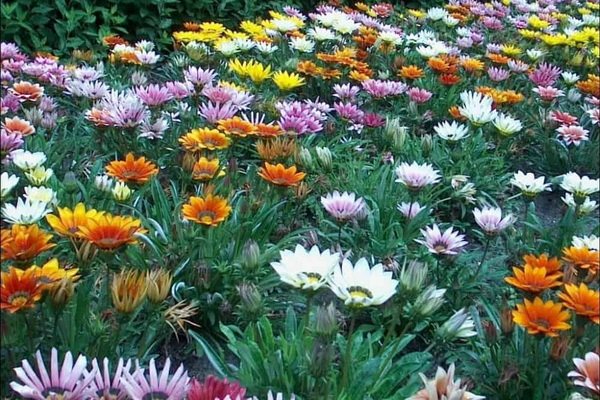

When plants reach a height of 10-12 cm, it is recommended to pinch them. This is done for better tillering. Before planting in open ground, it is recommended to harden the plants, taking them out to the balcony or terrace for 2-3 hours for several days in a row
During transplantation, it is important not to damage the overly sensitive root system. It is best to resort to the transshipment method, while trying not to disturb the existing earthen lump
Care. Agrotechnical measures for the care of arctotis include weeding, loosening, rare watering (only in very dry seasons). Being a native of Africa, these plants are quite drought-resistant and can take water from the deep layers of the earth.
Arctotis does not need compulsory dressings, in addition, it does not tolerate fresh organic matter poorly.
In order to achieve lush, continuous flowering, it is important to remove wilted inflorescences in time, this will provoke the active formation of new ovaries
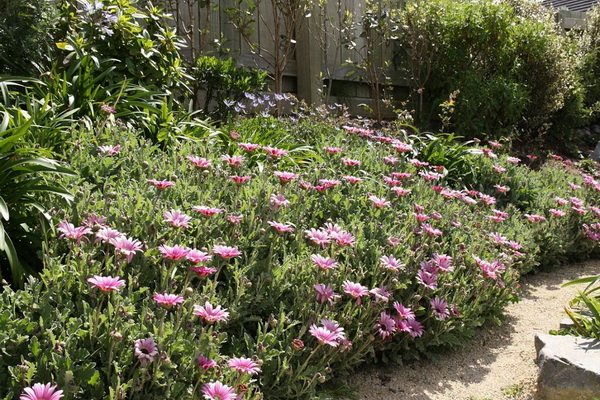

With an excess of moisture, Arctotis is susceptible to fungal infections, but insect pests practically do not threaten this plant. As a preventive measure, it is recommended to spray the bushes with a fungicide; Fundazol has an excellent effect. From folk remedies, an excellent harmless preparation is a mustard solution (in a proportion of 100 g of dry matter per bucket of water). Spraying with onion husk infusion is also recommended. To get rid of aphids, you can treat the plants with insecticides in the proportions indicated on the packages. Of the well-proven drugs, you can recommend "Aktellik", "Aktar" or "Fitoverm". If the summer is very dry, and it was not possible to avoid the defeat of gray rot, then the damaged plants must be completely removed.
These photos show the most basic points of planting and caring for an arctotis flower in the garden:
Arctotis varieties of bright cut colors are very effective.
Basic landing rules
When the seedlings have several full-fledged leaves, they must be transplanted into separate pots, and after a few more weeks, you can pinch the top. In this case, the flowers will not only stretch up, but also bush. It is necessary to plant seeds for seedlings in early spring, and ready-made plants can be planted in open ground in early May.
Arctotis seeds can also be planted outdoors in mid-April. In this case, it is necessary to make the required number of holes and water them abundantly with water. Several seeds are placed in each such hole and covered with earth. If the weather outside during this period is warm, then in two or three weeks they will certainly germinate. But in this case, the flowers will bloom only at the end of June.
You need to plant ready-made seedlings in a sunny and open place, since these flowers feel great in direct sunlight. Any land is suitable for them, but it is desirable that it contains sand. Therefore, for better growth of arctotis, sand can be poured into the ground yourself. You can also put a small drainage layer at the bottom of each flower bed, it will not allow excess moisture to linger in the soil.
In order for the flowers to set buds faster, a small amount of mineral fertilizer can be added to the soil. It is applied only once for the entire period of growth and flowering of the plant. You cannot use organic matter for these flowers, as it can only harm them. And in order for the plant to delight longer with its bright and interesting flowers, dried inflorescences must be cut off immediately.
If you need to prepare seeds for the next year, then you can leave several of these inflorescences. In two weeks, ready-made seeds will appear in them. Only they should be collected in dry and sunny weather. Within a few days, they need to be additionally dried and poured into a clean container. The seeds can be stored for up to two years.
Reproduction
In order to have arctotis in your garden, you can purchase ready-made seedlings in garden centers, or you can grow it yourself. The second option is less costly, but growing seedlings at home takes some time.
Growing seedlings
For sowing, it is best to take the seeds of the last year, since every year the germination rates deteriorate. The optimal time is considered to be the beginning or middle of April.
Seeds are sown in soil for seedlings or a self-prepared mixture of peat, black soil and sand to a depth of no more than 1 cm. It is advisable to treat the ground with a solution of potassium permanganate before planting in order to suppress the development of fungal microorganisms.To organize high humidity, cover the pot or planting box with a film, and put the container in a warm, bright place. The first seedlings should germinate in 10-14 days. Caring for them consists in periodically airing the sprouts and watering them.
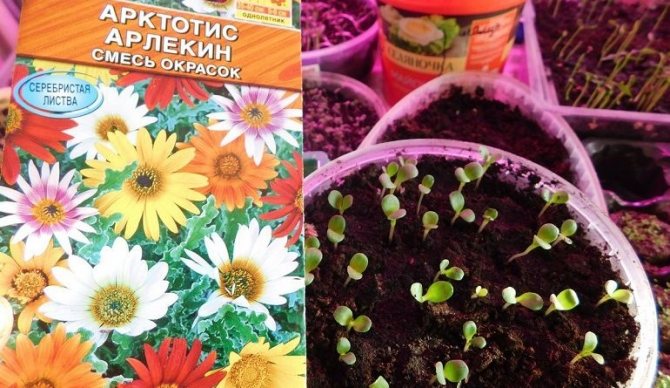

After about a month, the grown seedlings need to be cut into separate pots, where they continue to grow until the moment they are transplanted to a permanent place.
Before planting, the seedlings should be hardened, which consists in placing the pots outside on a daily basis with a gradual increase in the time spent in the open air. The last couple of days, you need to leave the seedlings to spend the night in the garden, after which they are considered fully prepared for transplantation. You need to land in a permanent place no earlier than mid-May.
Sowing in open ground
This method requires less attention and labor from the gardener, but shrubs grown in this way will begin to bloom later than those planted with seedlings. Sowing begins no earlier than the end of May in warm regions and in the middle of June in Siberia.
After the appearance of the first shoots and the formation of three true leaves, the planting should be opened so that it is not thickened. Excess arctotis can be left to grow in a new location.
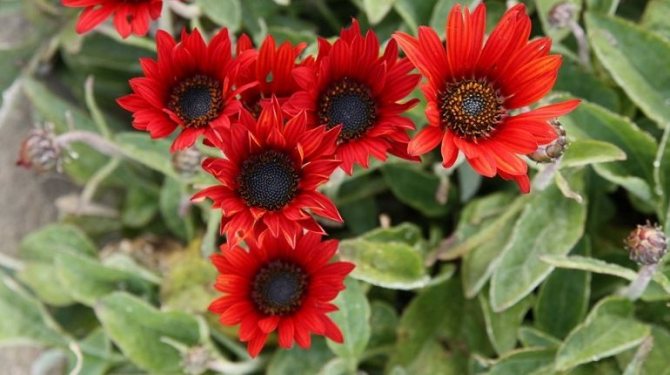

Application
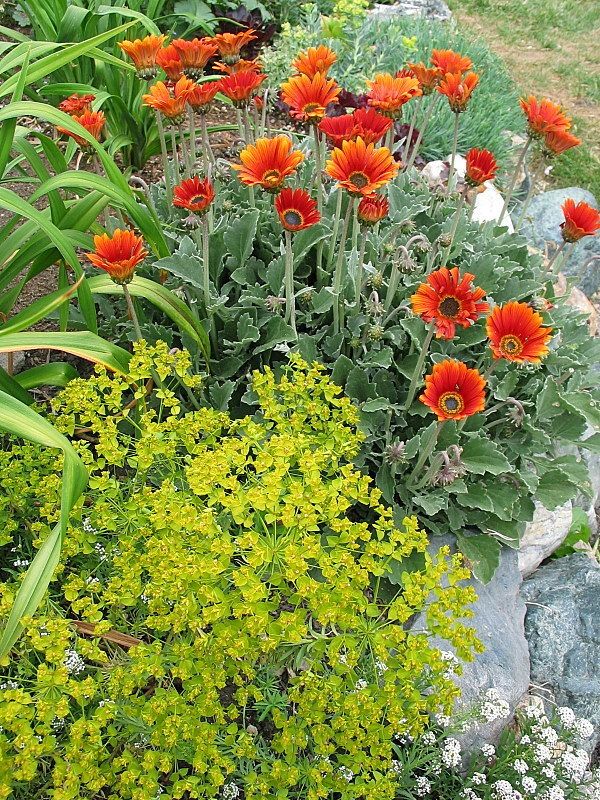

Arctotis bright orange, 'Pumkin Pie' variety, in rockery.
Examples of combinations:
Analallis (full color) ‘Wildcat Mandarin’ and ‘Pink Sugar’ arctotis.
Luxurious exotic flower bed with a magnificent combination of lines and colors. Such a solution, although not without difficulty, is quite possible to implement in the middle lane: Arctotis Flame, Little Maid knifofia, karyopteris, Bright Edge yucca.
Arktotis is successfully combined with ornamental grasses and many annuals:
- Verbena.
- Nasturtium.
- Marigolds.
Varieties and types
Arctotis stemless perennial species, forming thickets of small bushes. Leafy rosettes are lush, bluish hue. The height of the peduncles is up to 20 cm, the color of the flowers may vary depending on the variety.
Arctotis short-stemmed also a low look with shoots up to 15 cm tall. Almost no stems, for which it got its name. The flowers are yellow or close to orange with a dark center, placed on low peduncles.
Arctotis rough this representative is much higher than the previous ones - in the wild, it can grow up to 1 m, but cultivated rarely exceeds 50 cm. It has white or yellow ligulate flowers with a yellow or brown center.
Arctotis lush or large-flowered a plant that forms lush clumps with decaying stems, therefore, needs a garter. The flowers are mostly yellow or orange. This species has become the basis for many modern hybrid forms.
Arctotis stekhasolistny in garden culture, it is found much more often than others. It has tall shoots with large pubescent leaves. The ligulate flowers are white with a yellow spot at the bottom of the petal, the middle of the flower is dark purple. It was also often used in hybridization.
There are also quite a few varietal forms of different types. Here are some examples:
- Pink sugar - a variety with petals of light lilac color, which turns orange closer to the center of the leaf, and then turns into dark blue.
- Mahogany - numerous flowers of this variety are colored orange, smoothly turning into red tones.
- Hayley - gray-ash bushes are decorated with golden flowers.
- Flamingo - This variety looks similar to Pink sugar, but has wider baskets and bluish foliage.
- Brick red - tall bushes of these plants are decorated with bright red flowers with a dark center.
Also, quite often you can find the name arctotis harlequin Is a mixture of seeds of hybrid arctotis with different flower colors.
All the species and varieties mentioned above are perennial, but due to the cold temperate climate, they can be grown in our country only as annuals or in a pot culture (mostly stunted species).
Flowering bushes for the garden photos, names and descriptions of the best flowers
Fatshedera home care and transplant
When talking about what flowers to plant in the garden, one should not forget about the shrubs. One of the best flowers for a garden is definitely roses.
Rose is the leading plant among the beautifully flowering shrubs for the garden. By the nature of growth and flowering, roses are divided into 3 groups: park, repeatedly and continuously flowering and climbing.
The second group includes remontant, tea-hybrid, polyanthus classes.
Repaired roses. The flowers are large, rounded-cupped, double, mostly with a strong pink scent. They are located in 3-5 pieces on the shoot. The bushes are vigorous up to 1.5 m. The flowering is twofold: the second flowering is less abundant (autumn). They require winter protection from frosts below 10-12 °.
Hybrid tea roses. Bred by crossing remontant roses with tea roses. Flowers are varied in color (red, white, pink, yellow with countless transitions), different sizes - from large to very large, double, varied in aroma, 1 - 3-5 pieces per shoot. Bushes are on average 50-70 cm tall. The bloom is abundant both in spring and autumn and is longer than that of remontant roses. They require winter protection from frosts below -7 ... -8 ° С.
Polyanthus, or multi-flowered roses. The flowers are small (2-3 cm in diameter), red, pink, white, less often yellow, mostly double, fragrant and odorless, collected in large inflorescences. They bloom very profusely and almost continuously until frost (Excelsia is pink).
Climbing or curly roses. They have long (2 - 5 m) shoots creeping along the ground. The flowers are small. The color of the flowers is different. They bloom profusely and for a long time, but once in early summer. Among them, semi-twisted roses are of interest. Hardy enough, they hibernate without shelter.
Park roses. These are wild rose hips and their hybrid forms. They are hardy and do not require shelter. Roses are propagated by budding in July - August for two-year-old rosehip seedlings (grafted culture) and by cuttings (rooted culture) in June - July.
Roses grow better in sunny areas, loamy nutrient soils. They are planted in late April - early May, climbing at a distance of 1-1.5 m, remontant 60-70 cm, hybrid tea 40-50 cm, polyanthus 20-30 cm. Before planting, the shoots are cut shortly into 3-5 buds. In subsequent years, when growing roses, correct pruning is essential. It promotes good development of the bush and abundant flowering. In the spring, immediately after removing the shelter, sanitary pruning is carried out: all weak, dried, frozen and thickening shoots are cut out, then the branches are shortened. Thinning and removal of weak and dry branches is carried out in all types of roses, and shortening is not in all. Climbing and park roses are not pruned, as they bloom on last year's wood.
Repaired roses are cut (shortened) by 8-12 buds, counting from the base of the shoot (weak pruning), hybrid tea - by 3-5 buds. Roses are systematically fed during the summer.
An important technique when growing roses is to cover them for the winter. Most types of roses, with the exception of climbing and park roses, require shelter. It is carried out at the end of October with the onset of small but persistent frosts (-3 ... -5 ° C). Before the shelter, broken, diseased branches, flowers, unripe shoots and bushes are removed. Shelter is carried out with sawdust, leaves, peat. Good results are obtained by covering the roses with thick paper, which is applied to a special wire frame made to the size of the bush.
Here you can see photos of beautiful flowering bushes for the garden:
Jasmine (chubushnik). Unpretentious shrub, 1-3 m high. Blossoms in June-July with white double flowers with a strong odor. Propagated by layering, green cuttings.
Buldenezh. Terry form of viburnum ordinary, very decorative.Quite unpretentious shrub with beautiful white spherical inflorescences. Propagated by green cuttings.
Lilac. Terry forms of Sireya are very decorative:
Charles Joly
Star of May
Bertha Damock
Lauvazier
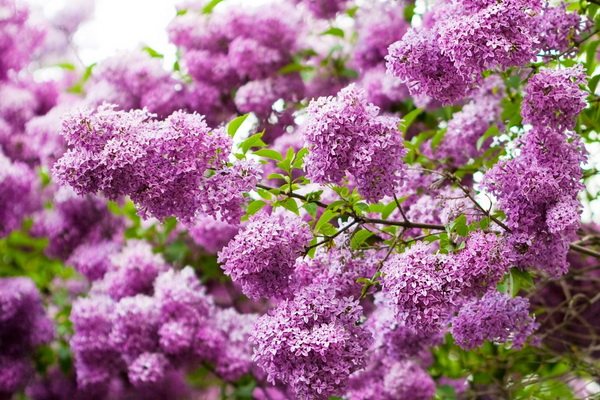

Mathieu Dambal
Non-double forms are also original: the Chinese variety has inflorescences up to 50-70 cm, abundant flowering. Propagated by cuttings, grafts, layering.
This selection of photos shows what flowers can be planted in the garden:
Care
The plant belongs to the undemanding class. Loves warmth, but not capricious, can tolerate cold. It is drought-resistant, although watering is necessary in extreme heat. For better tillering, the bushes will need a pinch, and to maintain a decorative look - timely removal of wilted inflorescences.
Problems
The plant can be affected by the following pests:
- Gall nematode.
- Meadow bug.
And also the "pest" is often the gardener himself, who diligently "cares" and floods the plant or uses fresh organic matter as fertilizer, which arctotis categorically cannot tolerate (they have enough mineral feeding for the season). So it is worth directing your desire to take care of other plants, and for arctotis the most important thing:
- Choose the right landing site.
- Grow strong seedlings.
- Plant it in open ground without disturbing the fragile root system.
- In the future, there will be enough loosening, removing weeds, pinching, removing wilted flowers, watering in a long heat - that's it!

